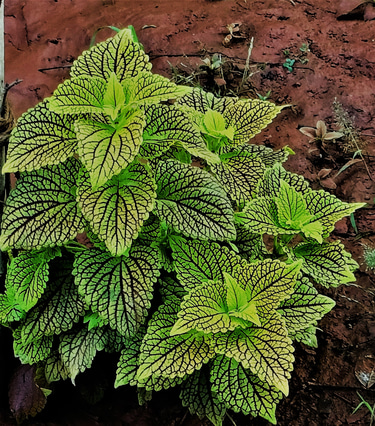Enticing pictures of wild flowers
Wild plants are those plants which grow without human interference, but still have to play great role in human life, especially among rural folk.
NATURE
satish Naik
4/11/202316 min read
What are wild plants ?
Scientifically speaking, wild plants are those which grow beyond human interference, but grown on there own. They are the plants which have not been exploited commercially and genetically. They are self sown and self nourished and still go grow stronger. Sometimes they compete with cultivated species for their survival. In this case, they are called as 'weed'. Being weed, they are invasive on cultivated farm and grass land and interfere with agriculture productivity . If not a weed, they are rather useful and have to play enough role in human life, especially in village folk. They are the source of fuel wood, fodder to live stocks and source of biomass to prepare composts and manures. Presence of variety of alkaloids and phyto- chemicals have made them medicinally potential and some with bio insecticidal properties.
The role of wild plants in natural balance can not be ignored. They provide the shelters to various reptiles and amphibians and food to many herbivorous creatures in the form of fruits, leaves, tubers and seeds. They contribute to biodiversity by breaking the mono cropping system of cultivation to some extent. They are sources of nectar to variety of bees and lepidopteran insects. Nutritionally rich delicious honey is a result of presence of these plants.
Presence of these plants conserve the soil form erosion. By having strong root system, they bind the soil firm and acts as a barrier against erosion. Dead and dried portion of such plants, on burying into soil, helps in humas formation with beneficial microbes, thus improves soil fertility.
Following are some of the pictures of flowers captured from wild herbs or shrubs or weed species noticed in surroundings to Godowns of Agricuture Marketing Committee, Mallaram, Nizamabad Districts, Telagana state. Flowers are usually tiny and photos are captured on enlarging for better clarity.
Silver Cox Comb is a herbaceous plant belonging to family Amaranthaceae, with scientific name Celosia argentea. These plants bloom from spring to summer. Flowers are hermaphrodite, lance shaped, arranged like plume-like heads, with varied color and brightness. The plants grow in an area of bright sunlight and well drained soils.
The leaves and flowers are edible in parts of west Africa and South East Asia. Domesticated plant becomes excellent source of cut flowers because of its longevity.
Celosia argentea: Silver Cox Comb
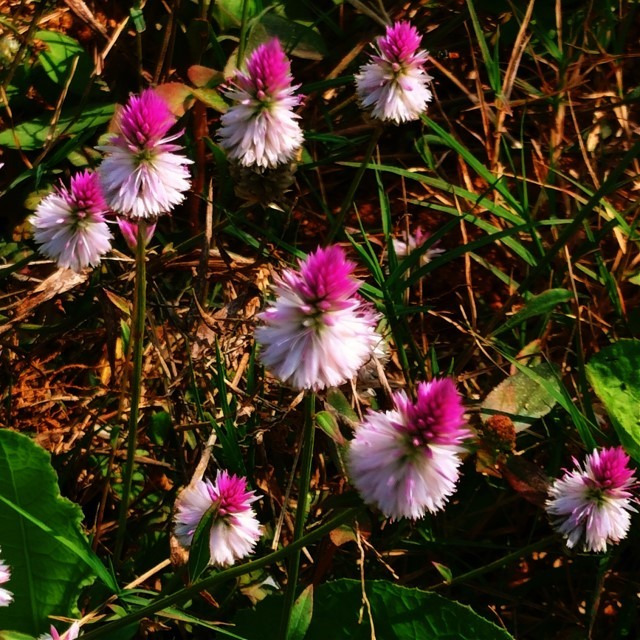
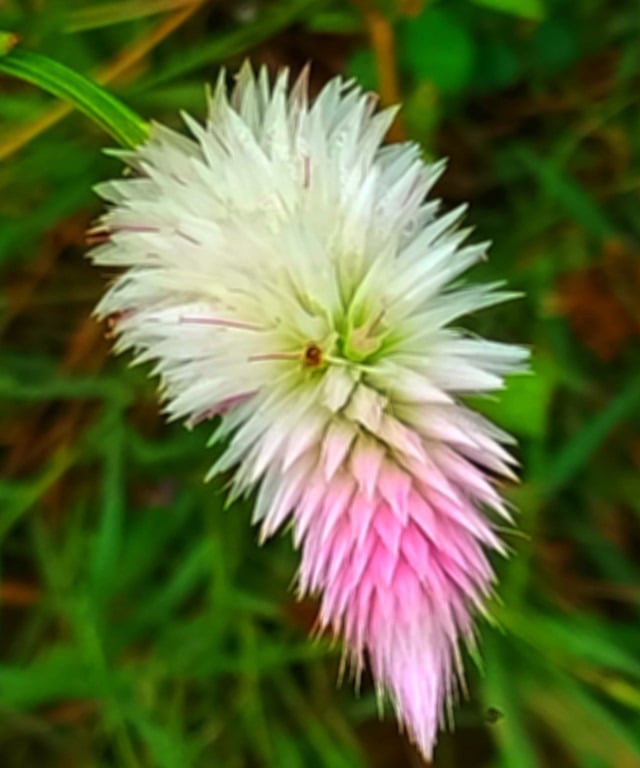
Lantana camara is a Verbenaceae flowering plant, a very adaptable species. Plant can thrive well in variety of ecosystem. It is a invasive weed and has the ability to compete and overtake the native species and cultivated crops. Plant produces some allelopathic chemicals, which suppresses the growth of surrounding plants by affecting their germination, root development and reproduction. Its ability to spread fast in farm and grass land affects both agriculture and livestock production.
Leaves of the plants are of oval shape, simple and opposite. Flowers are tubular, with four petals, arranged in clusters at apex of the stems. Color of the flowers varies from pink to orange or red to white or yellow depending on their position in the clusters. There occurs change in color of flowers on pollination, typically yellow to orange and pink to red.
Lantana Camara reported to be toxic to live-stocks and pets as plants produce certain phyto chemicals causing liver damage and photo-sensitivity when consumed.
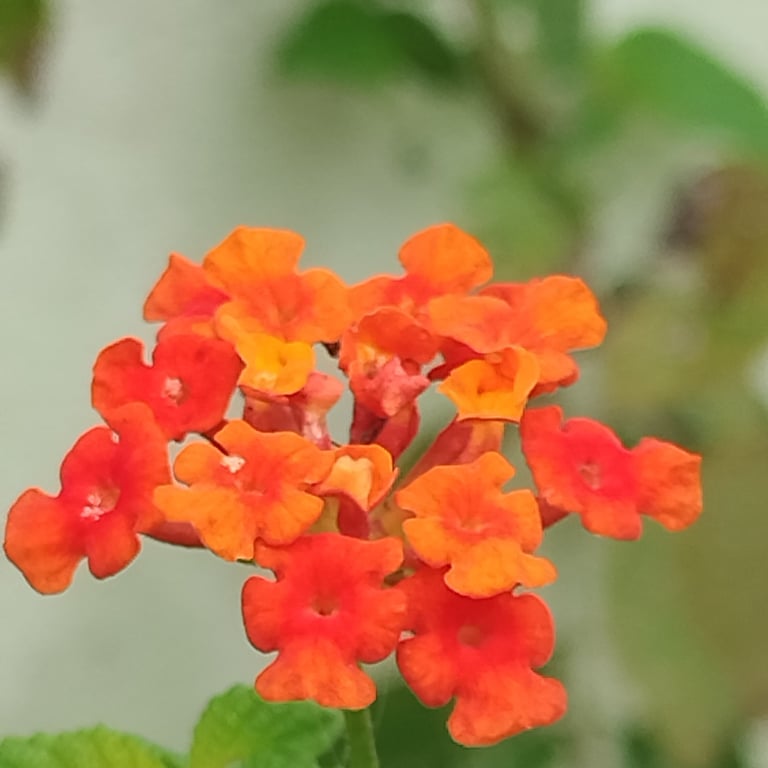
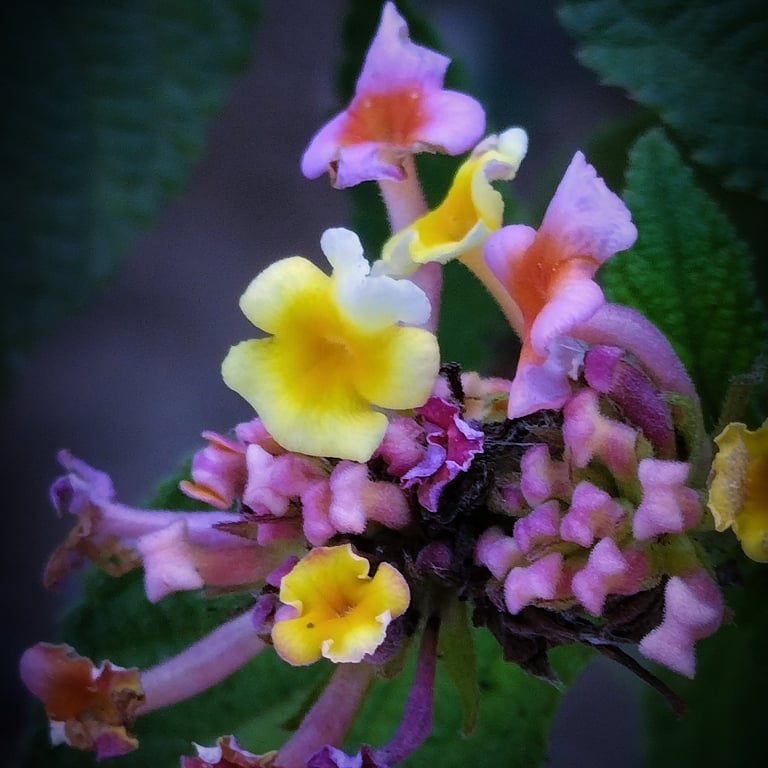
Lantana camara
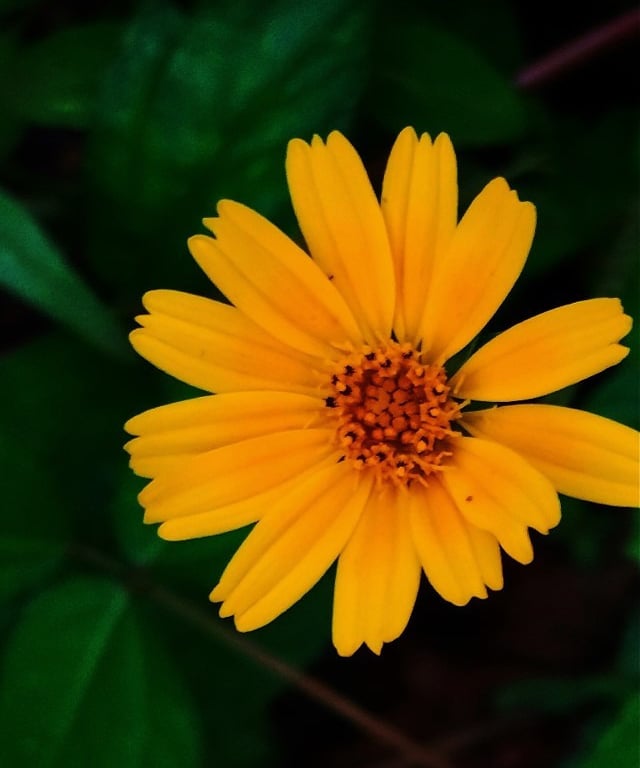
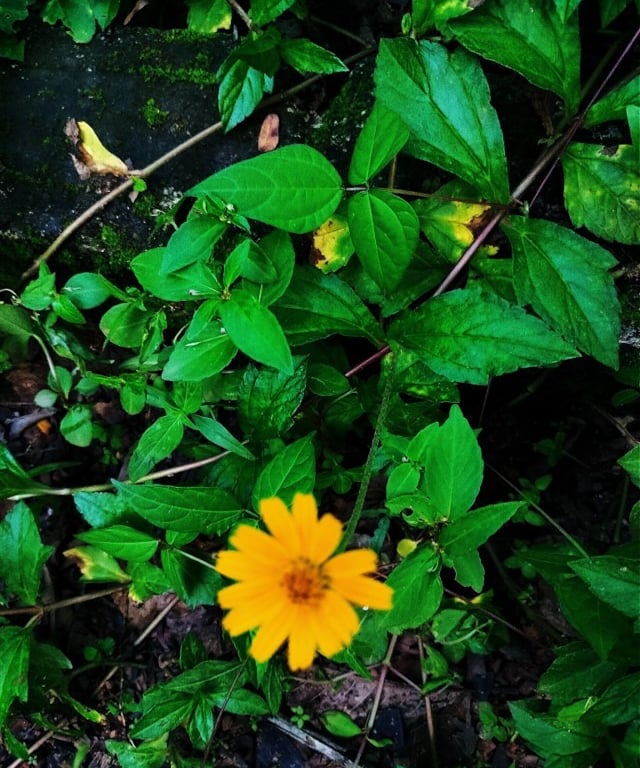
Sphagneticola trilobata: Singapore Daisy
Sphagneticola trilobata, a perennial herb belongs to family Asteraceae. It spreads on ground with the roots formed at nodes, grow up to the length of 30 to 40 cm. It is considered as invasive weed species because of speedy growth and spread to form dense mat covering the earth. The plant is commonly known as Singapore Daisy, Marigold Daisy Trailing Daisy, Wedelia and Creeping Oxeye.
Plants are cultivated for ornamental ground cover as they produce attractive bright yellow flowers with beautifully arranged florets. They are easy to propagate using cutting and fast growing. Leaves of the plants are fleshy, covered with hairs, serrated and laterally lobed.
Muntingia calabura, a shrub or tree belongs to family Muntingiaceae, named in honor of Abraham Munting, a Duch botanist. The leaves are alternate, distichous and lanceorate, with toothed margin and covered with short hairs.
Flowers are solitary with five sepals and five obovate white petals with groups of stamens and yellow anthers.
Timber of the trees are used as fire woods. Usually grown as ornamental and shade purposes, sometimes for source of nectar in apiculture industries.
Trees are commonly known as cotton berry candy or Panama berry or Strawberry tree or jam fruit berry or Jamaican berry.
Muntingia calabura

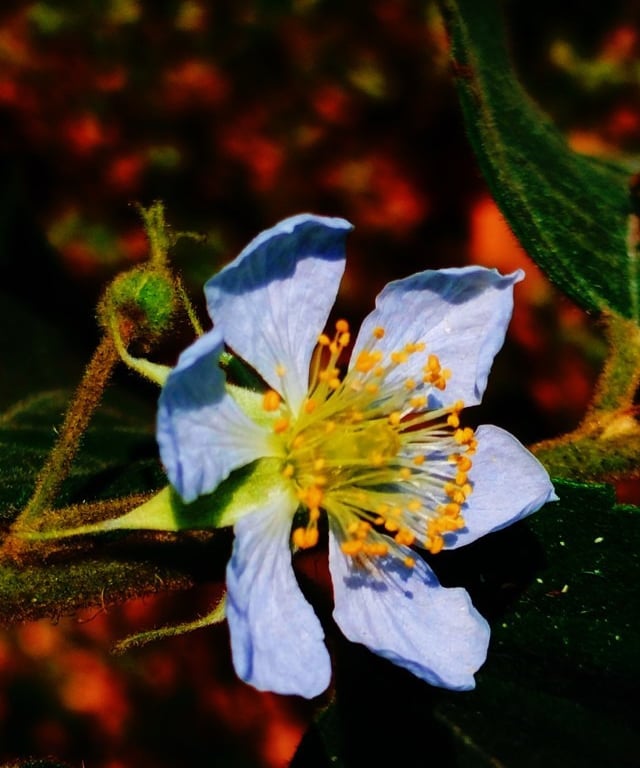
Datura innoxia, otherwise known as pricklyburr is of Solanaceae family. These are sub-shrubs and with stems and leaves are covered with tiny hairs.
Leaves are elliptic with pinnate arrangements. On crushing any part of the plant, emit rancid odor. Flowers are trumpet shaped and whitish in color. Bears egg shaped fruits with spiny surfaces. On ripening, fruits split open to disperse seed. Seeds have long viability and remain dormant in soil for many years.
All parts of plants are toxic to humans, live stocks and pets because of presence of tropane alkaloids. .
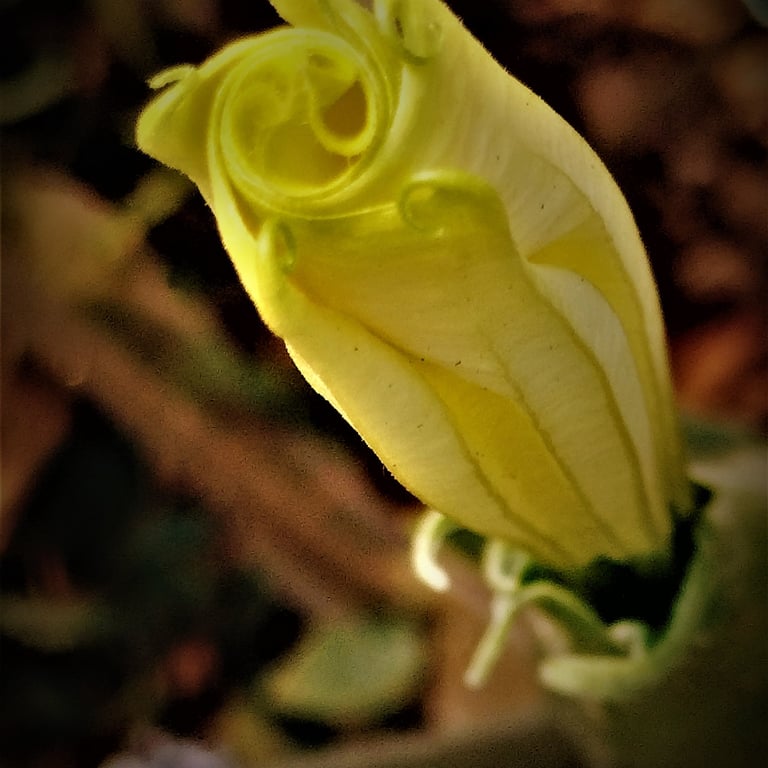
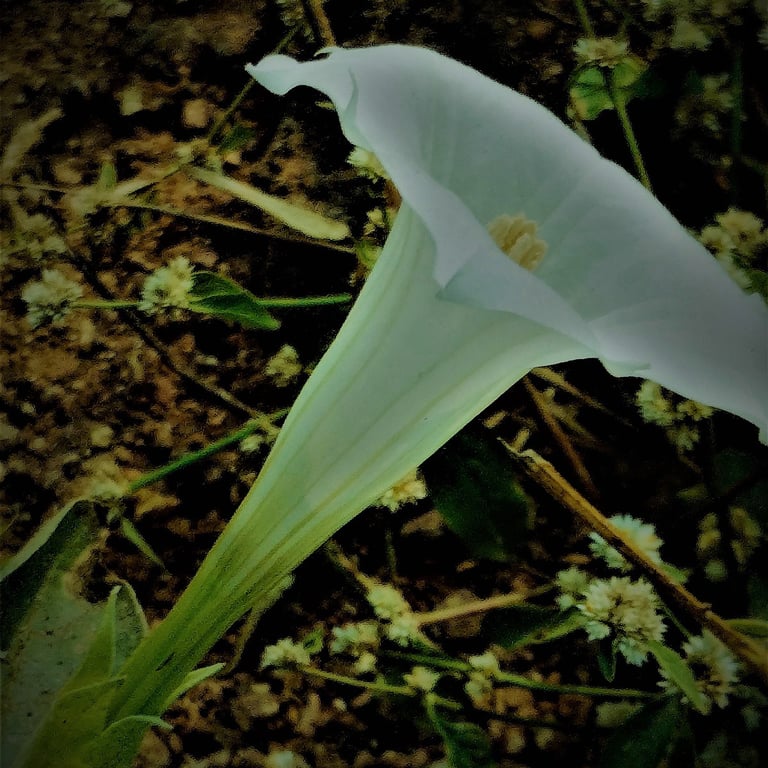
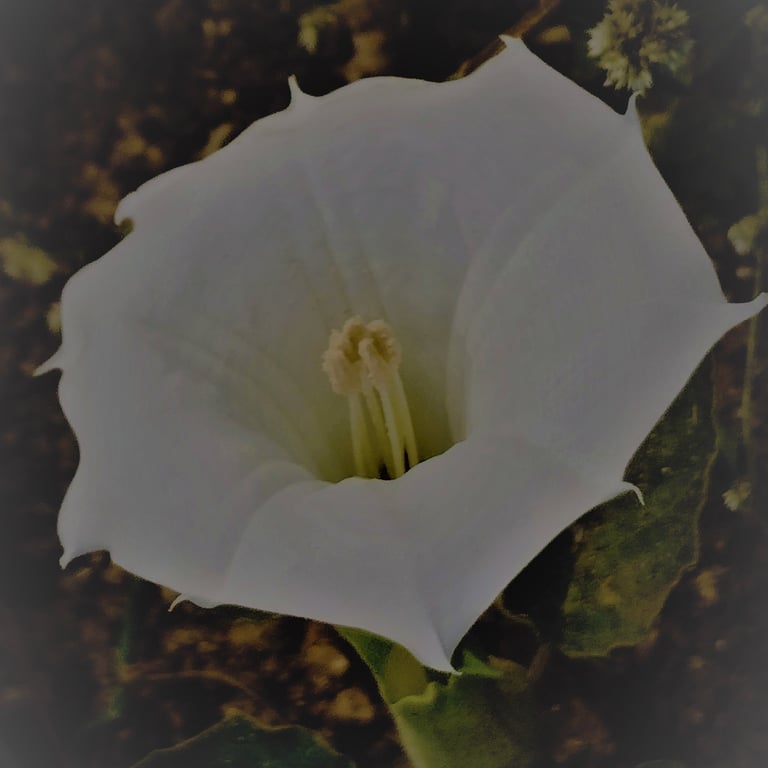
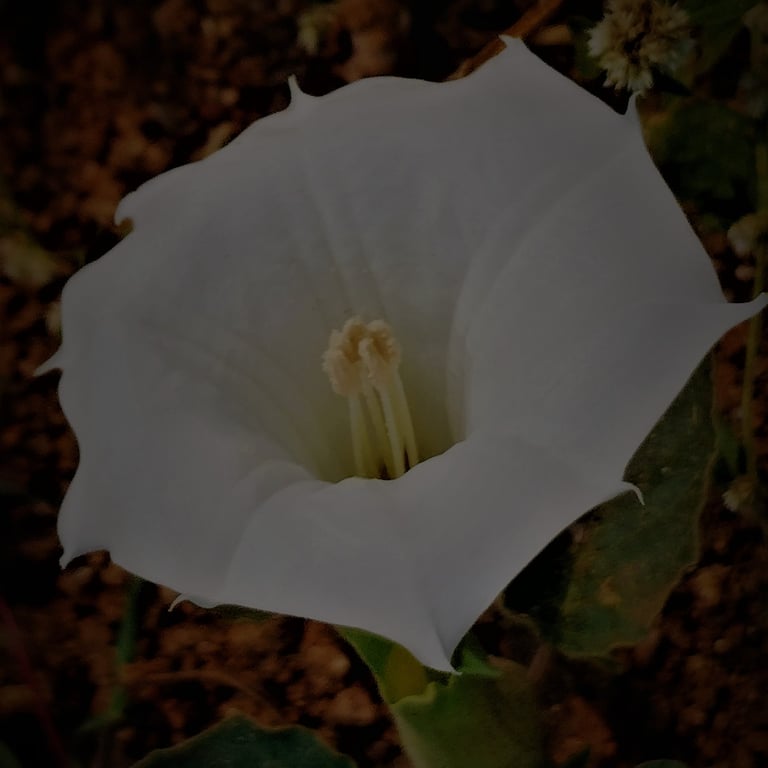
Datura innoxia
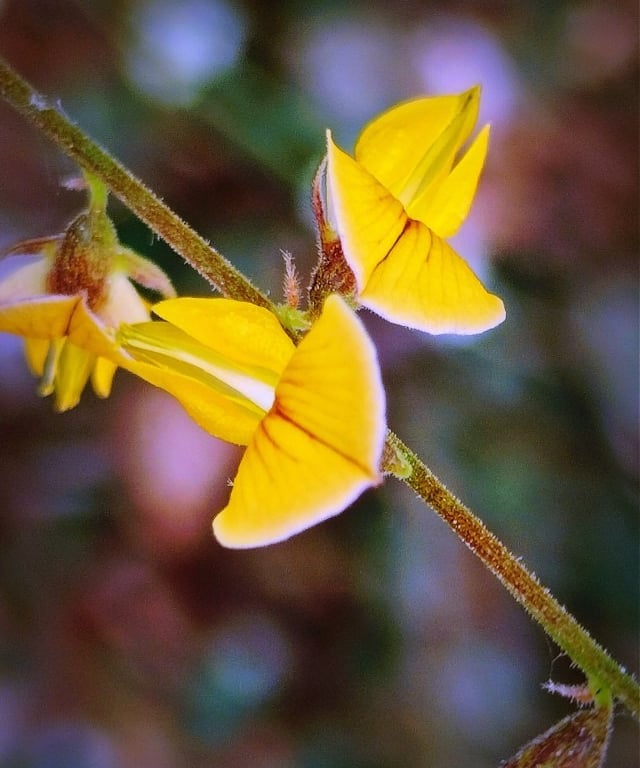
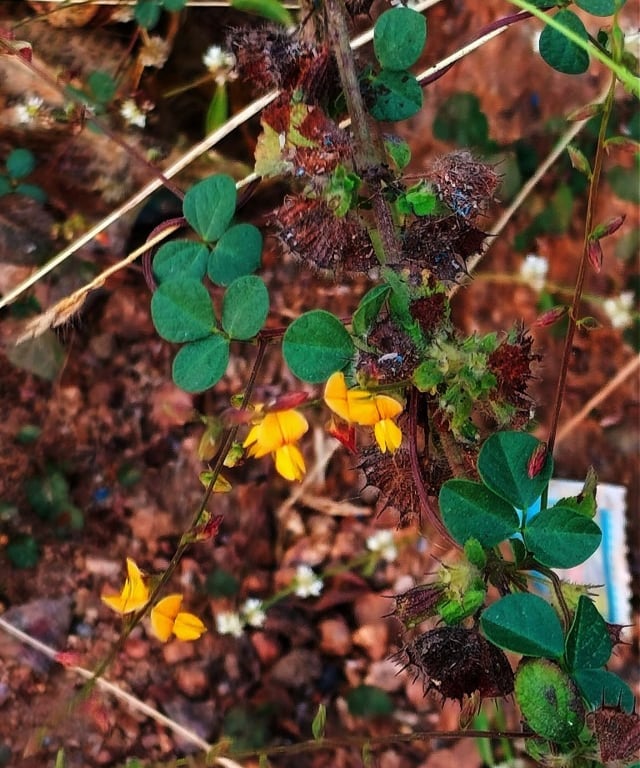
Rhynchosia minima: Burn mouth vine
Rhynchosia minima is a leguminous plant belongs to family Fabaceae. It is otherwise known as Least Snout Bean, Burn Mouth Vine, Jumby Bean . It is perennial twinning or trailing herb which grows to the length of few meter. Flowers are racemose inflorescence with 12-15 flowers per raceme. Flowers are of yellow color with brown or purple veining.
Billygoat weed, scientifically known as Ageratum conyzoides, a highly invasive weed, of family Asteracece.
Here leaves are ovate and flowers are whitish in color, some time pink or purple also. Tiny seeds get spread through sticking to skin of animals, clothes of humans or agriculture implements.
Ageratum conyzoides: Billygoat weed
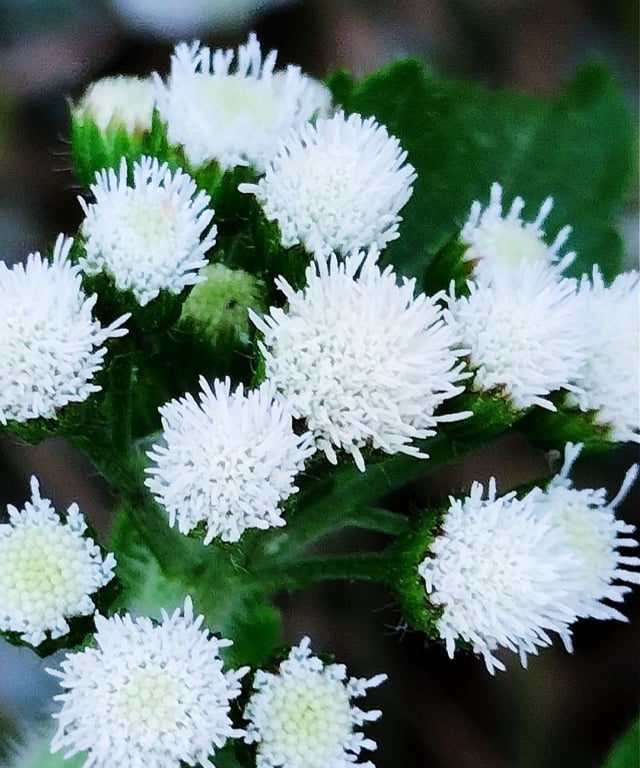
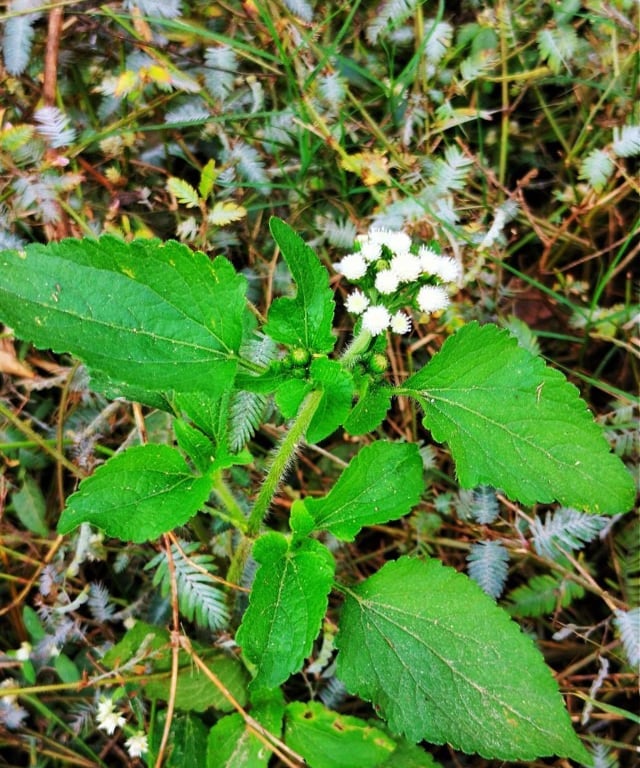
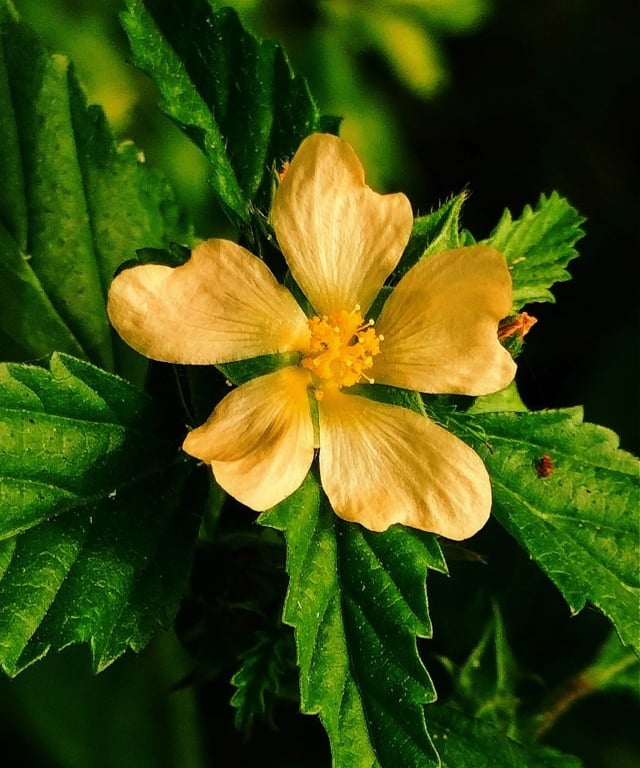
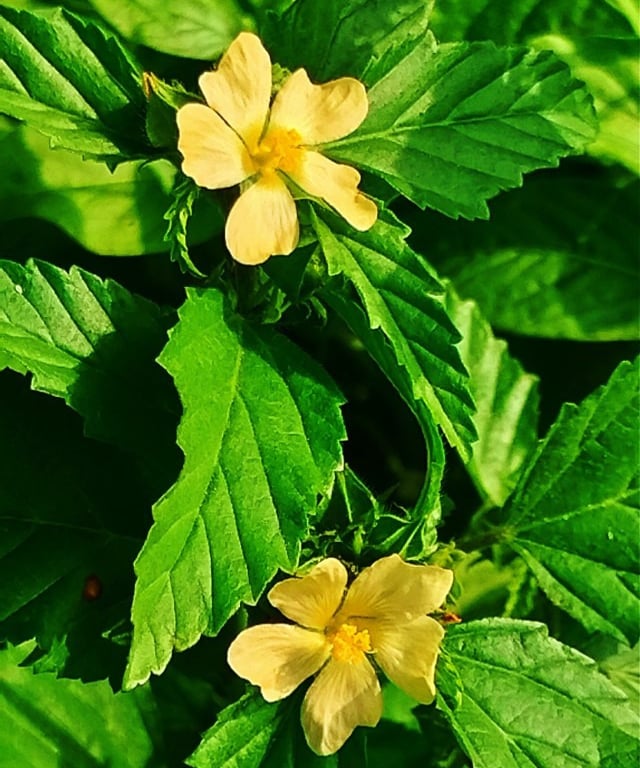
Malvastrum coromandelianum: False Mallow
Malvastrum coromandelianum which is commonly known as Three Lobed False Mallow. It is a native of North and South America. It belongs to family Malvaceae. Plant is also known as Broom weed, Clock plant, Sannabindige Gida. It is herb with which grows to the height of one meter. Leaves are ovate with serrated margin. Flowers are of light yellow color, produced at the leaf axils singly.
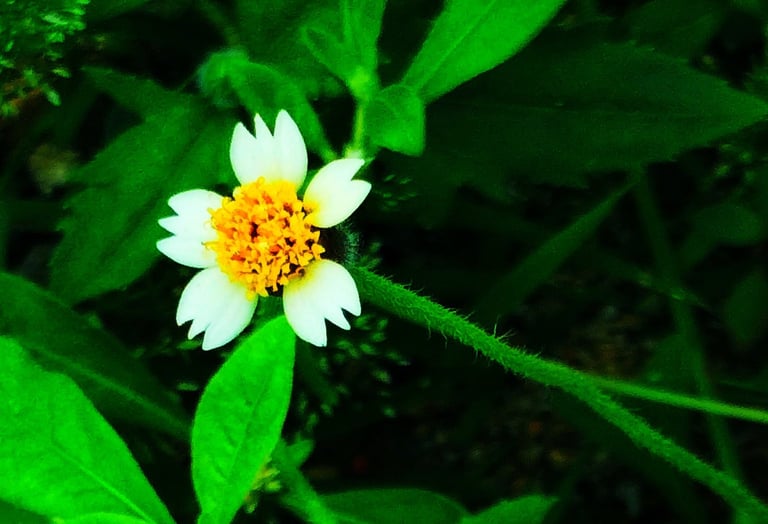

Tridax procumbens, commonly known as Coatbutton or Tridax daisy. Plants belong to family Asteraceae. It is common weed plant, native to Mexico and South America and have become invasive all over the world. Plants produce achene type of fruits covered with stiff and feathery hairs and plume like papus at one end. Single plant can produce thousands of such achene and same can be carried to considerable distance with wind.
Plants bear yellow centered white flowers with three toothed petals. Plants produce a flavonoid called procumbenetin.
Tridax Daisy
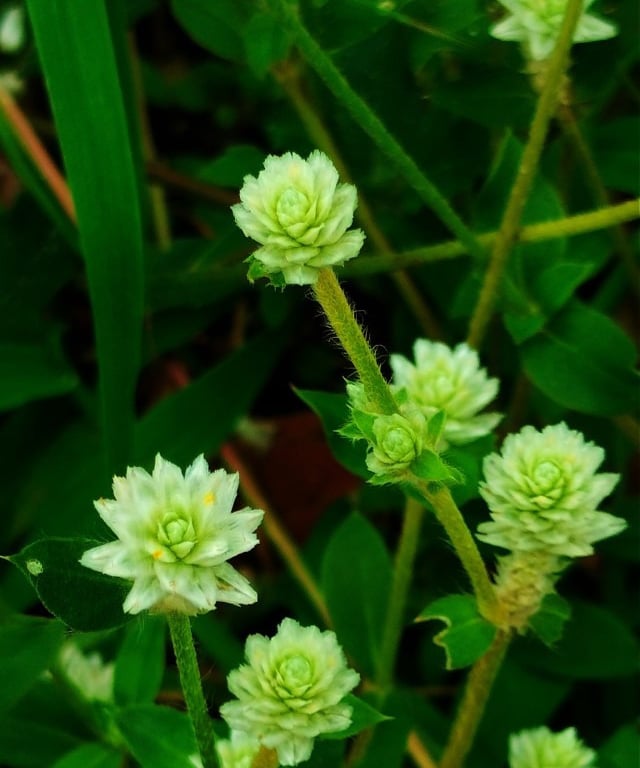
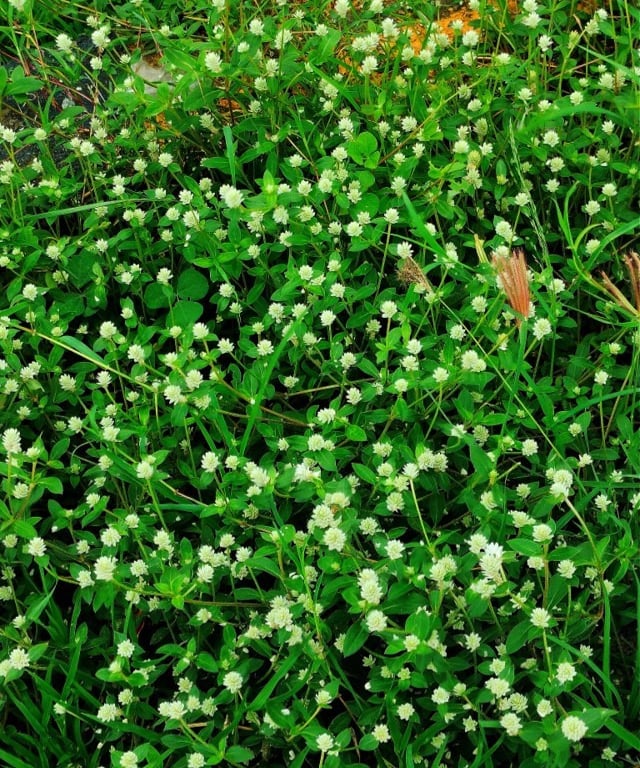
Alternanthera sessilis: Sessile Joyweed
Alternanthera sessilis belong to family Amaranthaceae.These are perennial plants with prostrate stem which roots at nodes. Leaves are petiolated, obovate or laceorated. Flowers are sessile spike with creamy white color. These are invasive weeds which spread fast with ease. Plants are otherwise called Sisso Spinach, Brazillian Spinach, Sessile Joyweed, Dwarf Copper Leaf.
Plants are being used as vegetables in some parts of south East Asian countries and some part of India.
Triumfetta rotundifolia is a shrub belongs to family Malvaceae. It is commonly called as Round leaf Burr Bush.
Here leaves are round, base are wedge shaped with toothed margin. Plants produce yellow flowers on interrupted racemes and bear fruits in capsules covered with hooked spines.
Triumfetta rotundifolia
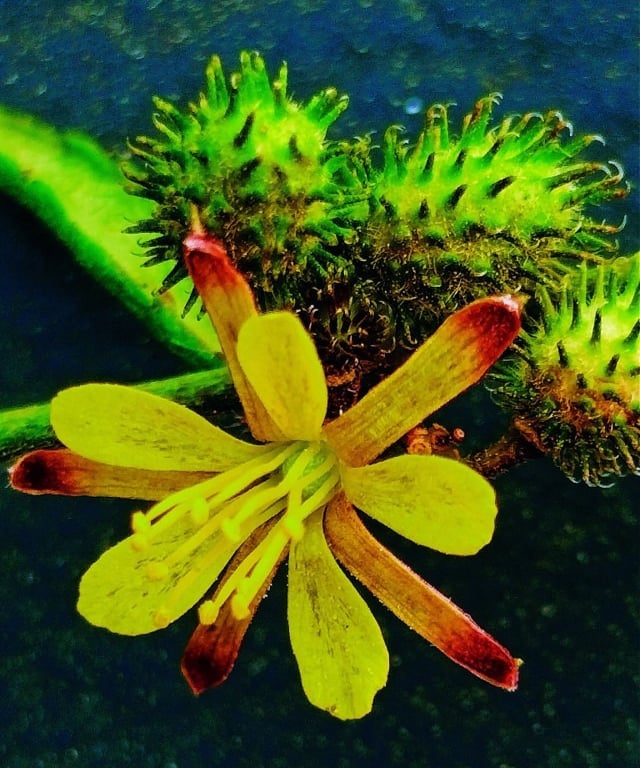
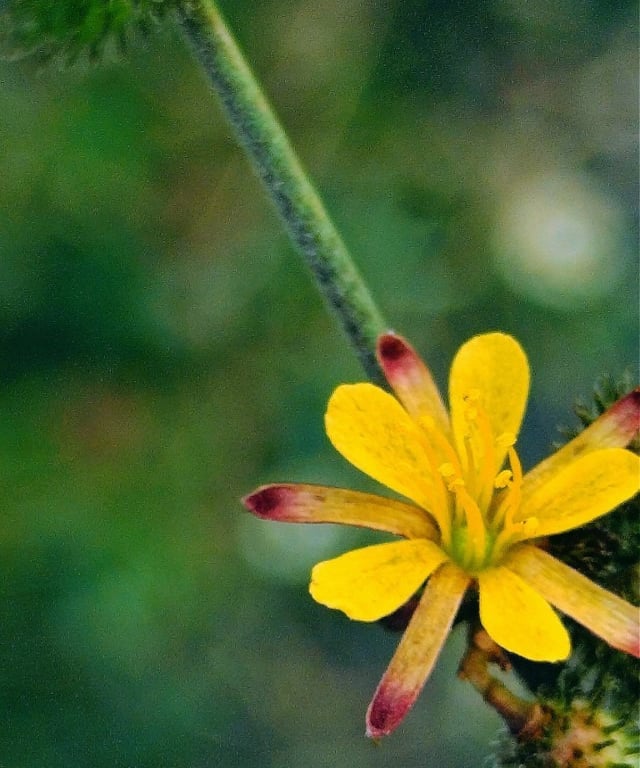
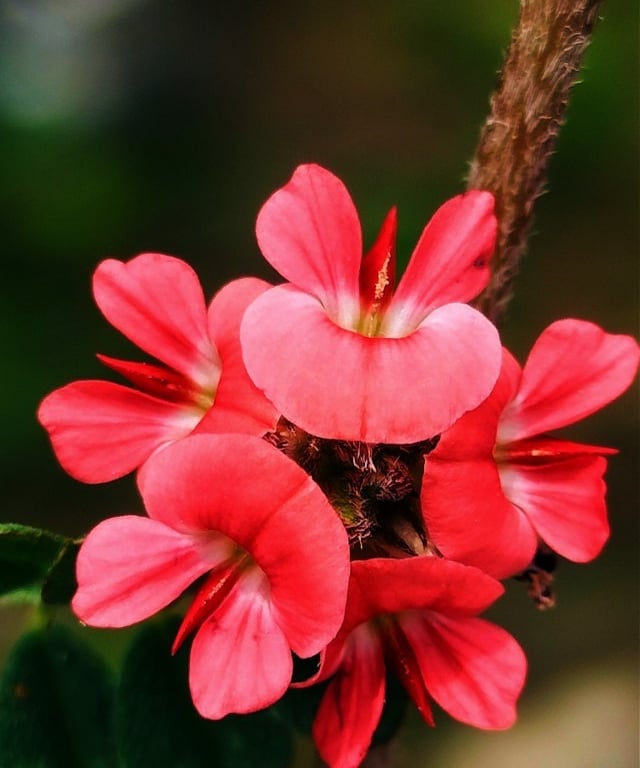
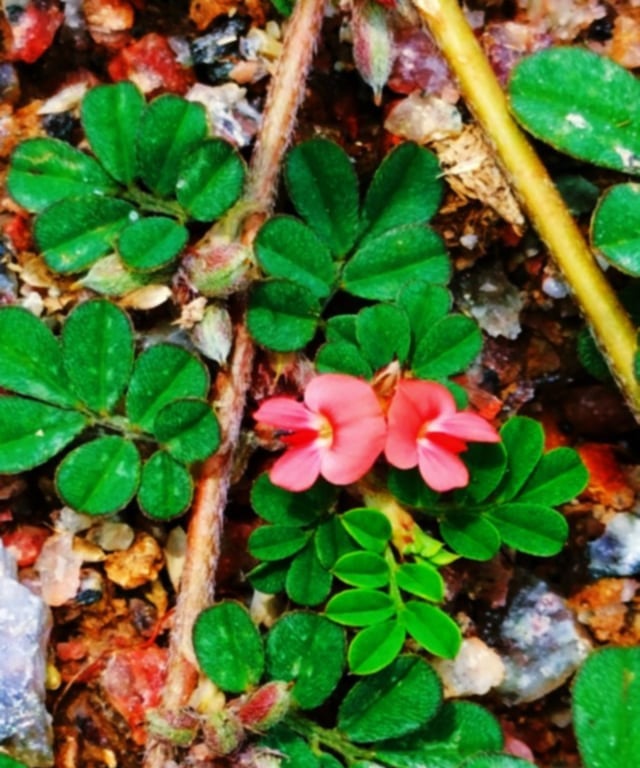
Indigofera linnaei: Birdsvillae indigo plant
Indigofera linnaei is a leguminous plant in the family Fabaceae. The plant is commonly known as Birdsville Indigo and Nine Leaved Indigo. It is a woody shrub which is a prostrate type that grows to the length up to 20-50 cm. Plant bears compound leaves and leaflets are arranged alternatively. Red flowers are produced in inflorescence.
These plants show some degree of toxicity on grazing animals. On feeding the plants horses can develop birdsville disease because of presence of some neurotoxins.
Acmella uliginosa, otherwise known as Marsh Para Cress plant, belongs to family Asteraceae.
Plants are scrambling or creeping herbs with lanceorated narrow leaves. Flowers are heads, yellow in color, solitary and radiate. Flowers produces achenes in the form of fruits with papus at the base.
Acmella uliginosa: Marsh para Cress plant
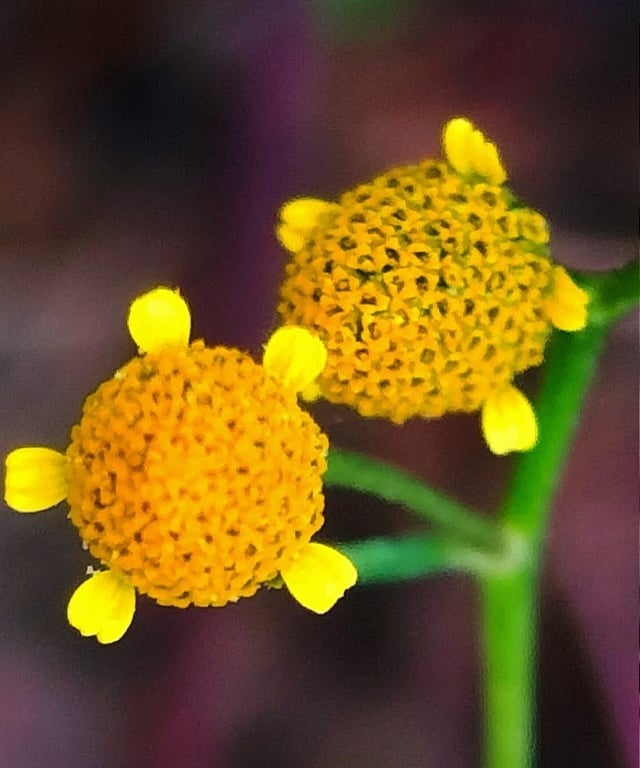
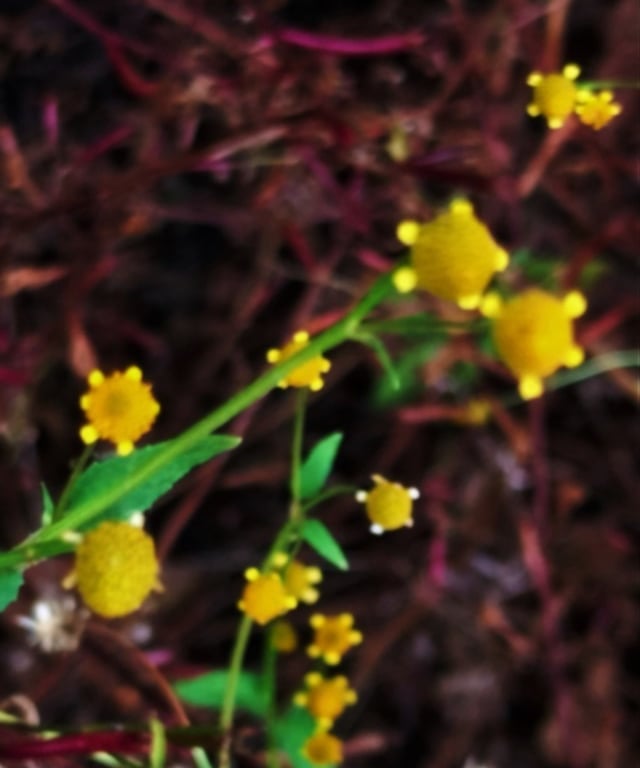
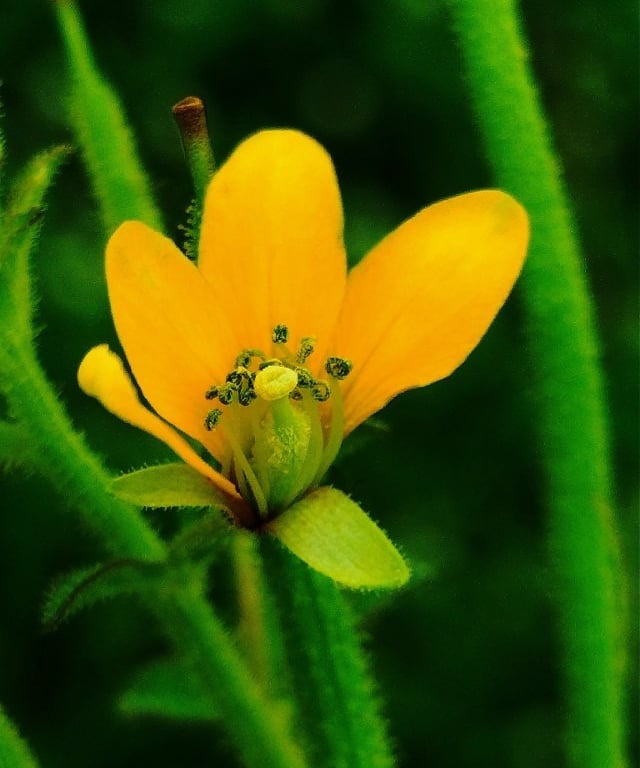
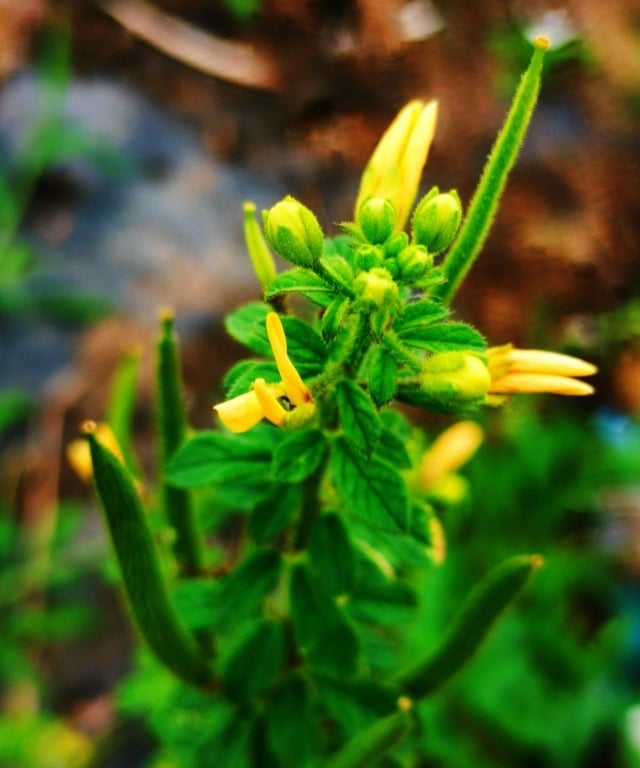
Cleome viscosa: Spider flower plant
Cleome viscosa belongs to family Cleomaceae. Common name of the plant is tick weed or Spider flower. It is an annual herb which grow to the meter height. It is invasive weed in warm and humid regions. Appear especially in rainy season. Plant bears petiolated hairy leaves. Flowers are bright yellow and petals are arranged in semicircular pattern.
Crushed leaves have been reported to have insecticidal properties and can be used in storage of pulses. Same has reported to have antimicrobial properties and can be used to heal wounds.
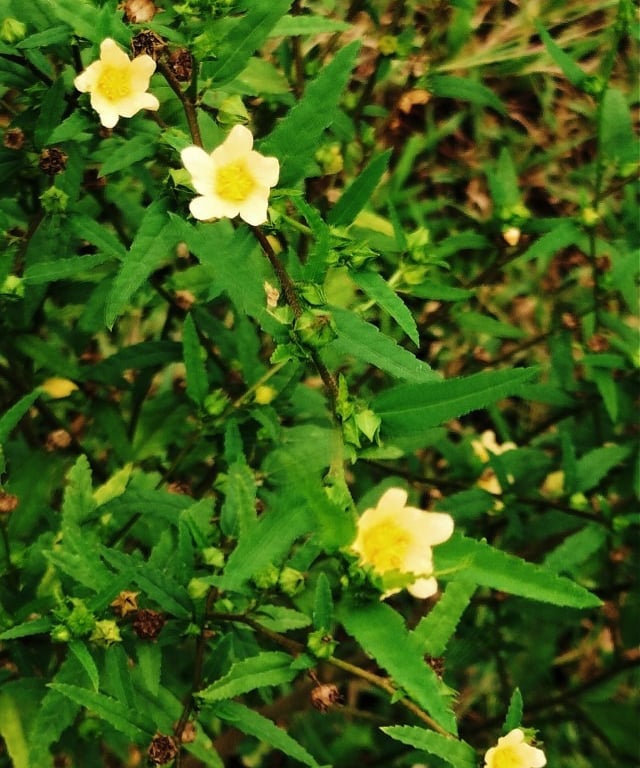
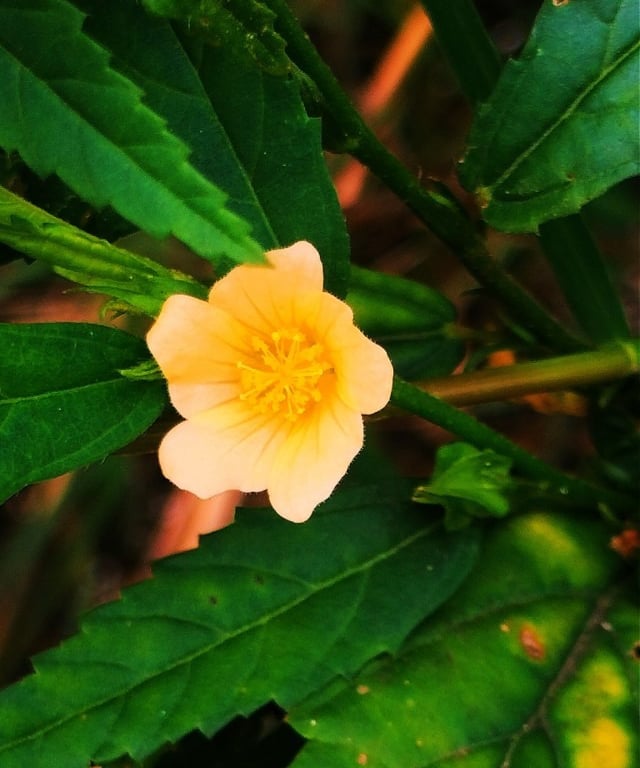
Sida acuta: Wire weed plant
Sida acuta, otherwise known as wire weed plant, belongs to family Malvaceae. It is a erect herb with alternate simple leaves. Flowers are produced in cymose inflorescence. Flowers are of light green color with five petals. It is a invasive weed in many countries. In Australia, a beetle named Caligrapha pantherina has been introduced for the biological control of this weed.
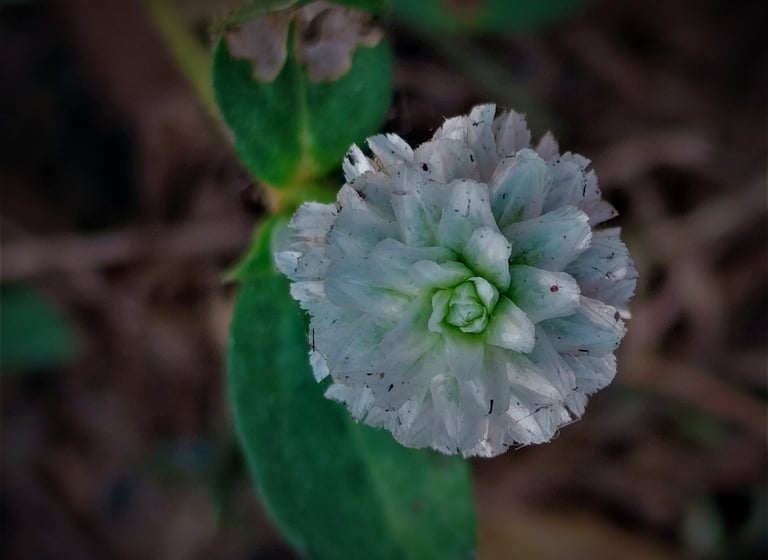

Gomphrena globosa, a Amarathaceae herb, commonly known as Globe Amaranth. It is heat and drought tolerant plant thrives well in summer.
Plants bear roundish inflorescence with various colors from white to purple or red or orange. They are known to produce as many as twenty seven phyto -chemicals in the form of flavonoids, betacyanins and volatiles. Presence of volatiles and flavonoids attract bees, butterflies and other insects, helps in pollination.
Gomphrena globosa: Globe Amaranthus
Ipomoea eriocarpa, commonly known to be tiny morning glory, belongs to family Convolvulaceae
Plant is a twining or prostrate annual herb with hairy stem. Plants produce lanceorated, ovate-oblong leaves. Plants bear pink or purplish short stalk, bell shaped flowers, with stamens which do not protrude out side the flowers.
Ipomoea eriocarpa
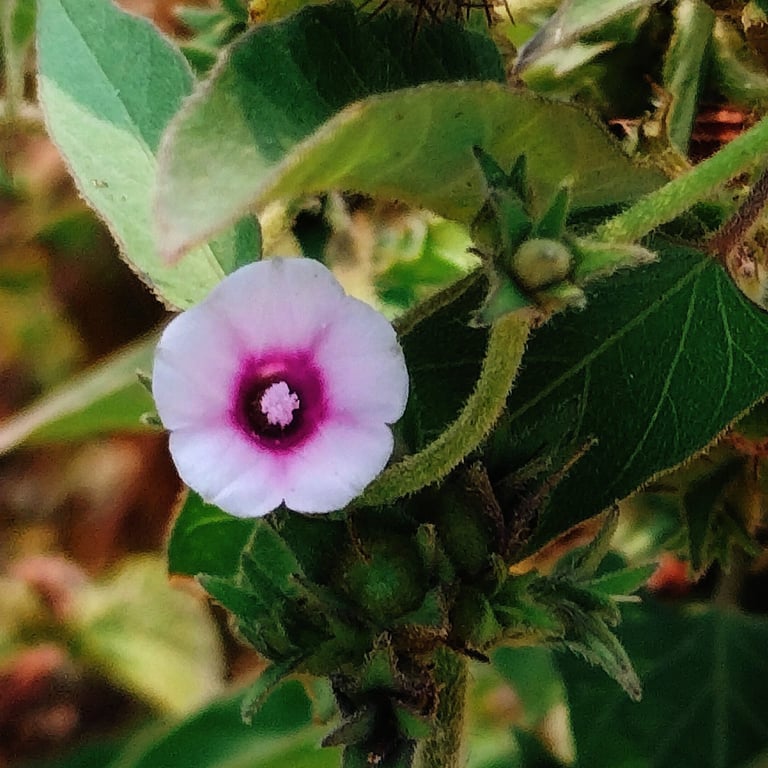
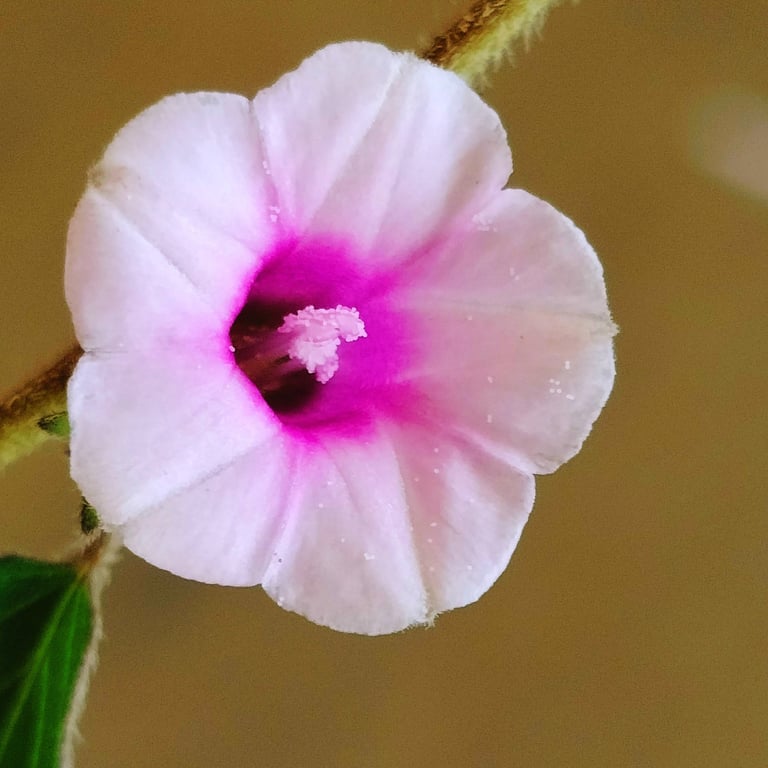
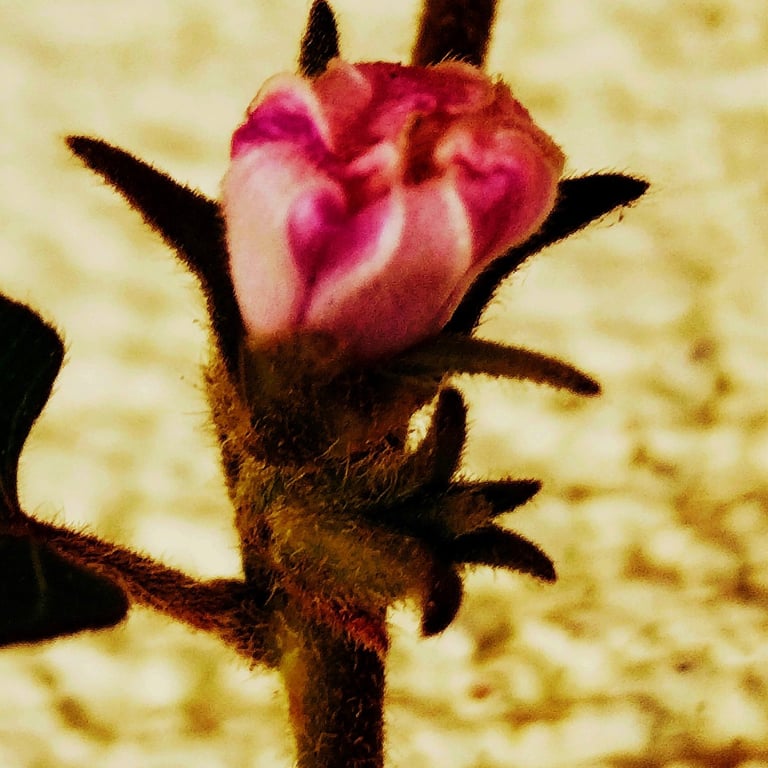
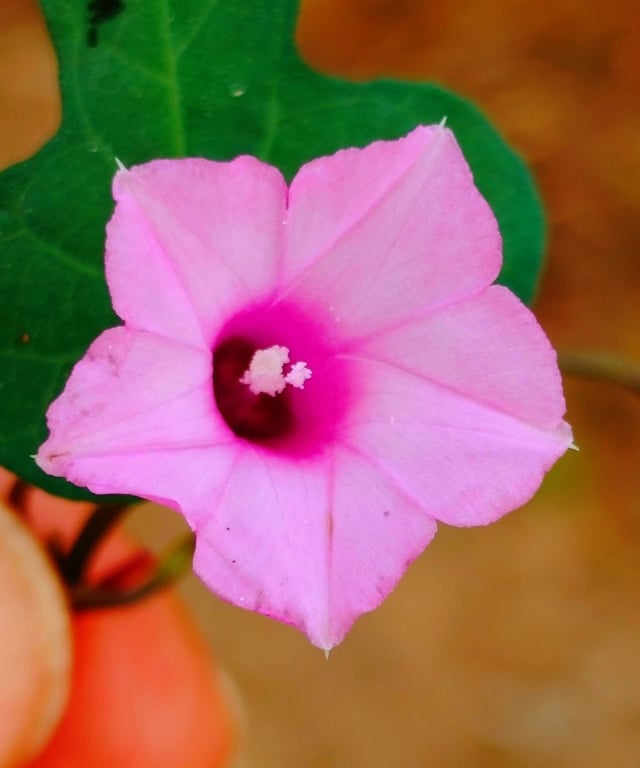
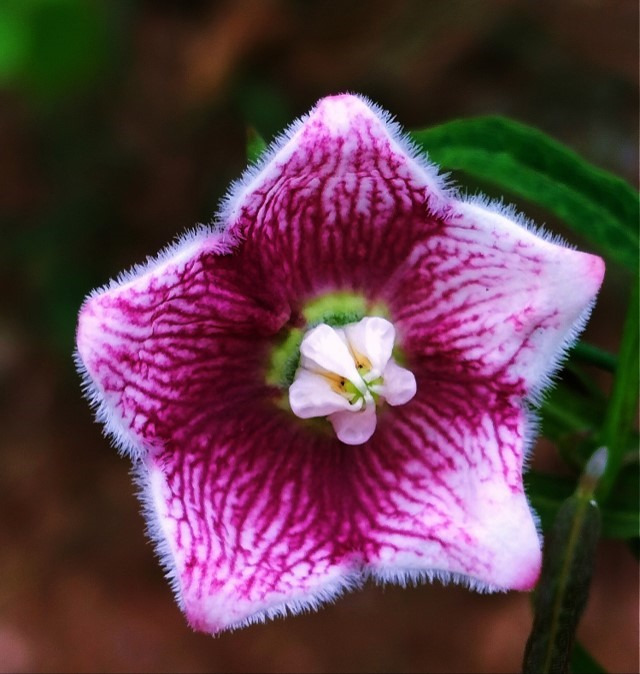

Oxystelma esculentum: Rosy Milk Weed Vine
Oxystelma esculentum is of family Apocynaceae. It is native China and other South East Asian countries. Plant is commonly known as Rosy Milk Weed Vine. It is a perennial creeper which grows to the length of 1-2 mt. Leaves are narrow, lanceorated, alternately arranged. Flowers are produced in racemes. Flowers are saucer shaped whitish in color with pink or purple veins.
Calatropis is a flowering plant, belongs to family Apocyanaceae, with Calatropis gigantea and Calatropis procera are more common species. It is commonly known as Milk Weed because of the latex it produces. Leaves are opposite, ovate, with or without stalk.
Plants bear white or pink to purple flowers in the form of umbellate cyme. C. gigantea grows to a height of 8 to 10 ft where as C. procera up to 3 to 6 ft. C. procera bears fragrant flower and C. gigantea bears non fragrant flowers.
Presence of calatropin, a phytotoxin, in latex makes the plant toxic to live stocks on feeding.
Calatropis plant
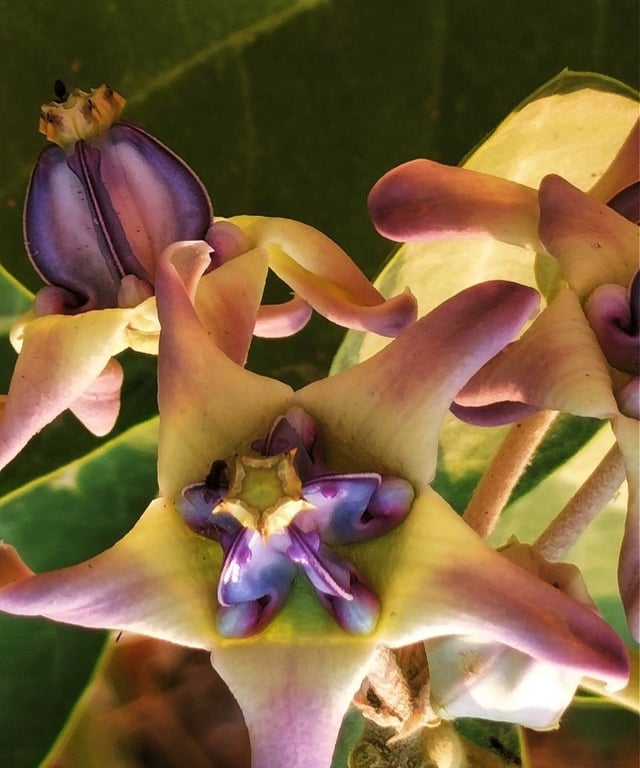
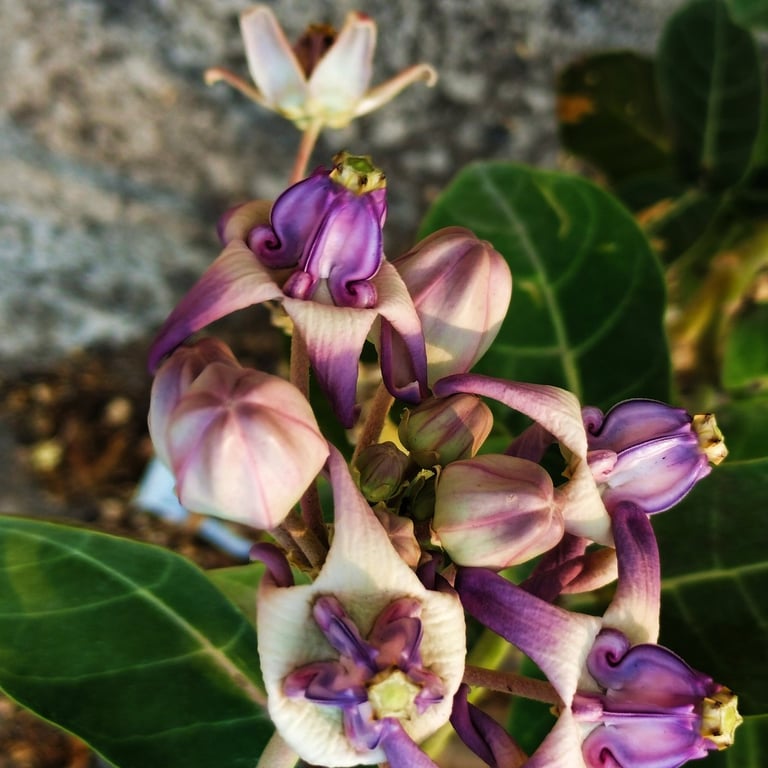
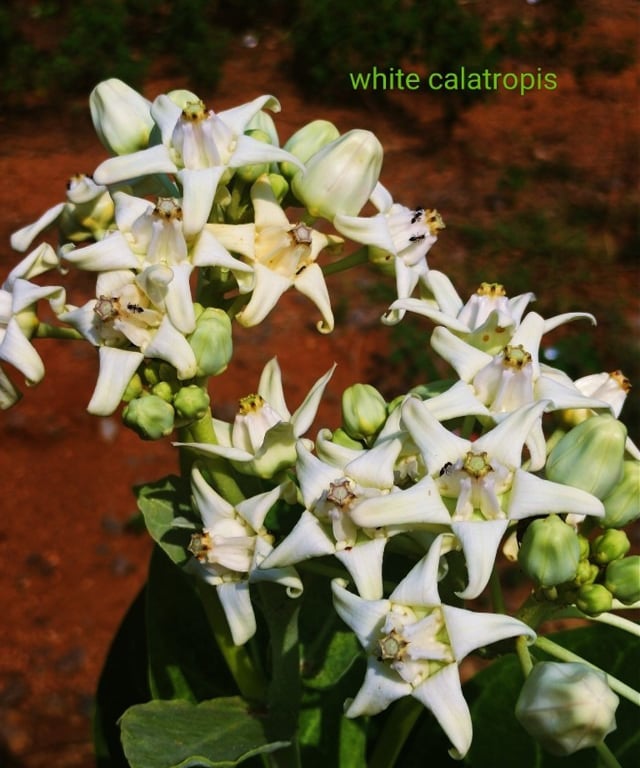
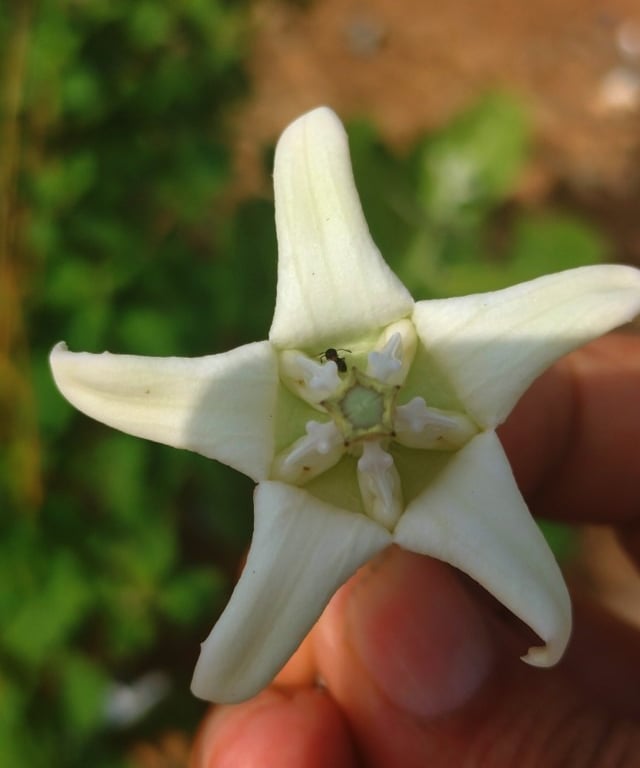
Solanum virginianum: Indian Night Shade Plant
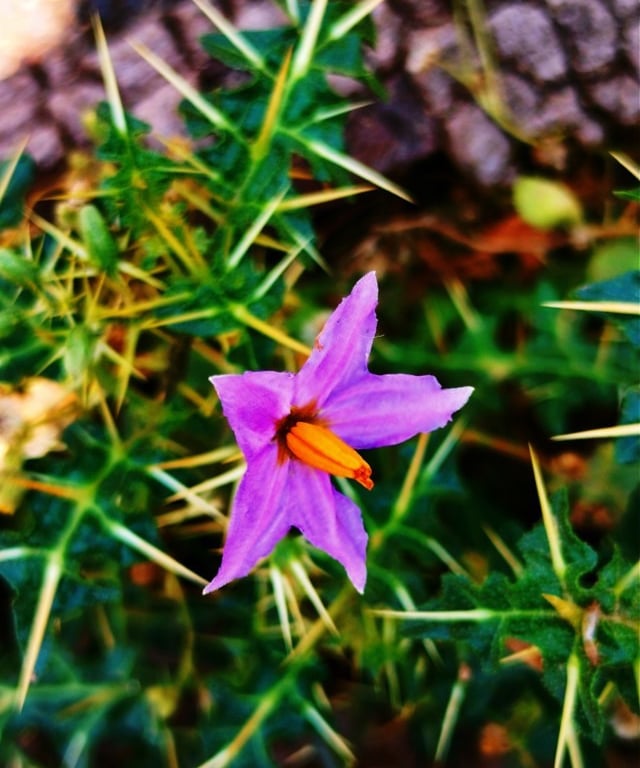
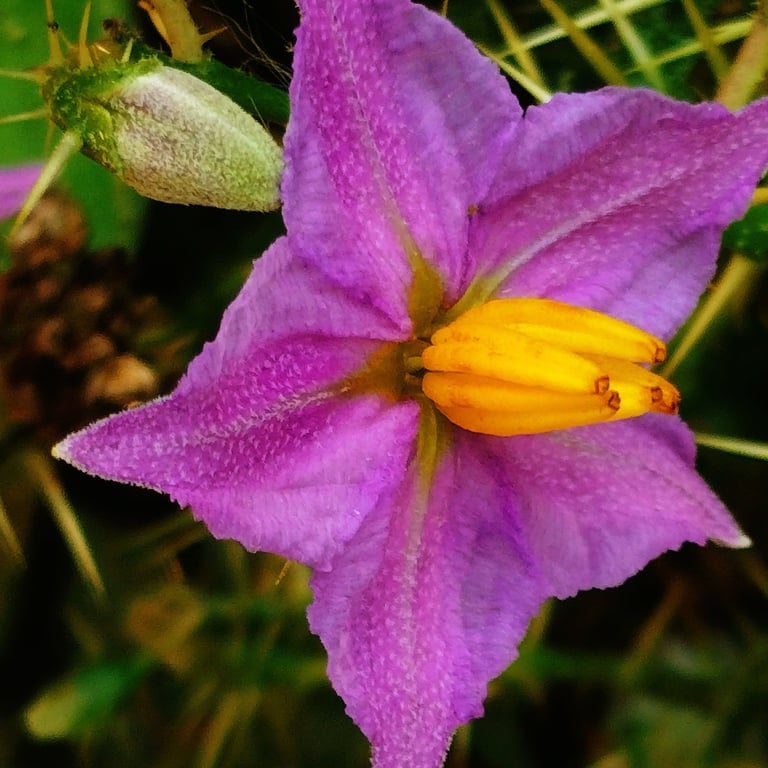
Solanum virginianum has different common names like Indian Night Shade, Yellow berried night Shade, Surattence night shade and Thai green egg plant. It belongs to family Solanaceae. It is a woody erect herb that grows up to the height of 2-3 ft. Plant is armed with needle like prickles on stem and leaves. Leaves are broad ovate- oblong, unequally lobed.
Flowers produced are purple, pubescent and few centimeter wide. Flowers appear during November to May. Fruits are yellow colored berries.
Plants are reported to have some medicinal properties because of the presence of some phyto-chemicals like polyphenols, flavonoides, alkaloides and glycosides.
Hygrophila auriculata, a herbaceous plant belongs to family Acanthaceae. Plants are usually grown in marshy place, hence called as Marsh Barbel.
Plants have tetragonal stem with hairs all over it and hairs are stiffer at nodes. Leaves are lance shaped, elliptical. Flowers are purple or violet in color.
All parts of the plants reported to have medicinal use. Plant parts are burnt into ashes or in any other forms, used as medicinal purposes.
Hygrophila auriculata: Marsh Barbel
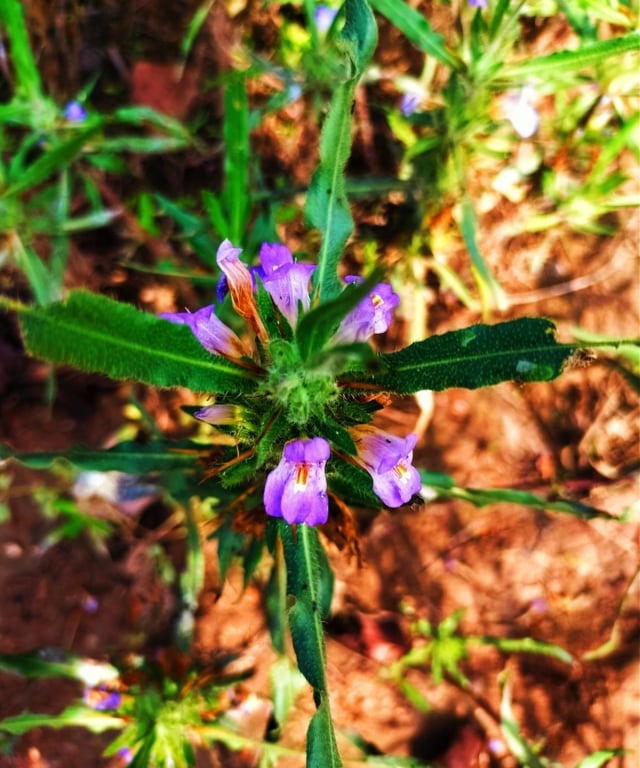
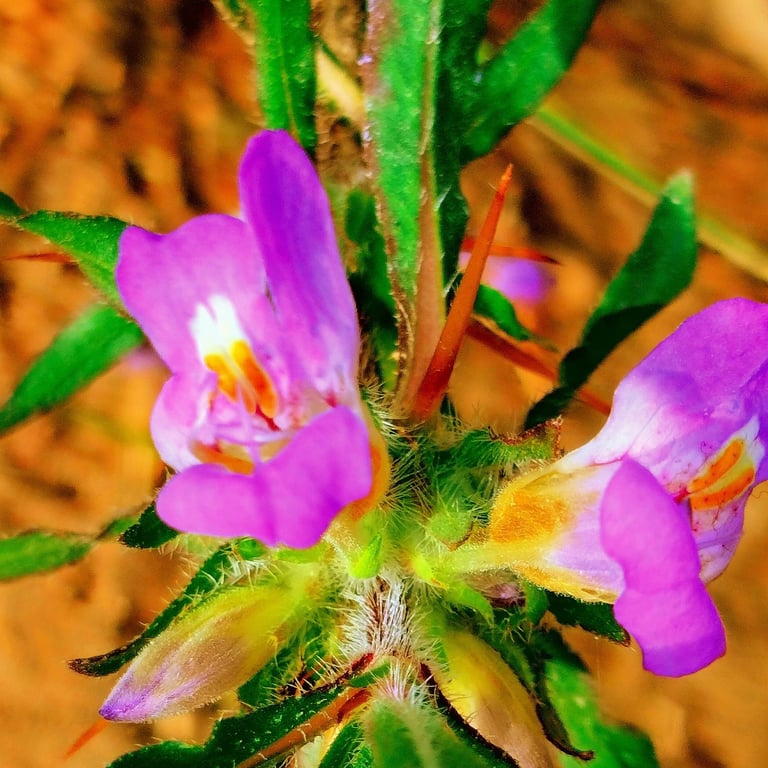
Tradescantia virginiana: Virginia spiderwort
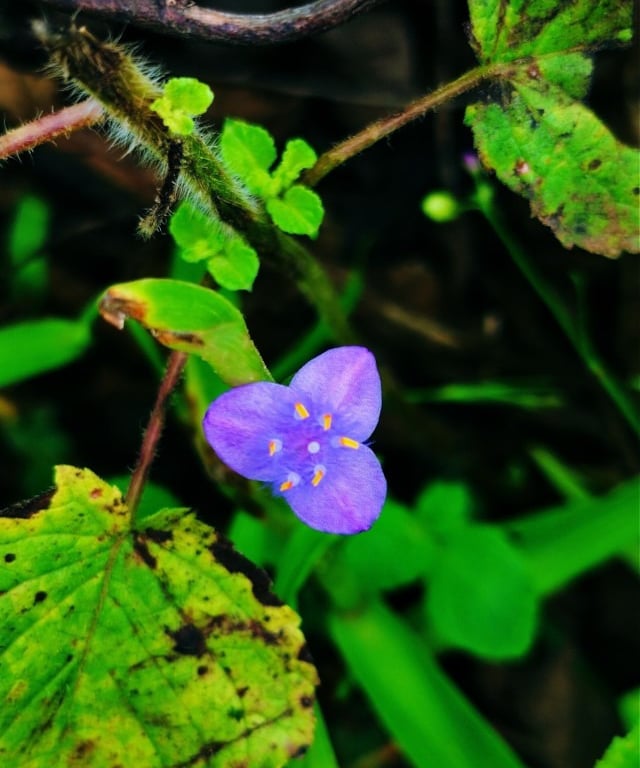
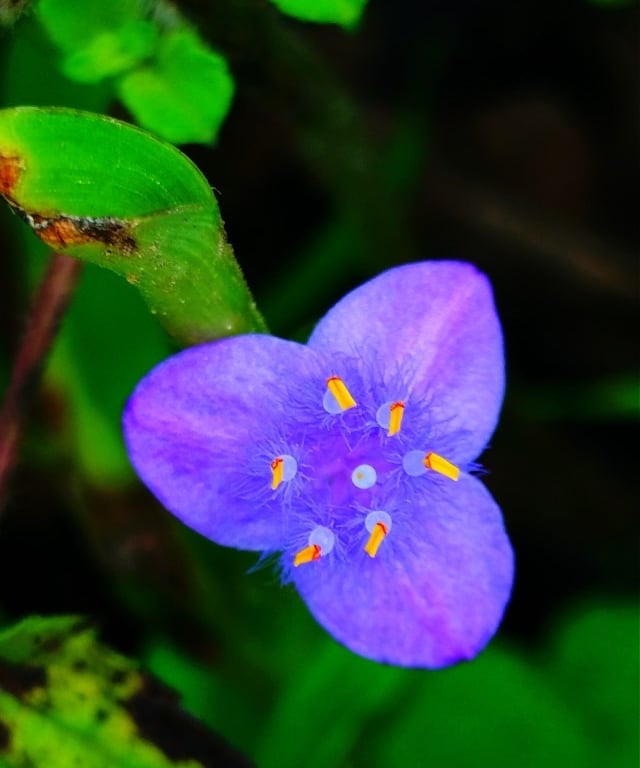
Virginia Spiderworts are scientifically known as Tradescantia virginiana, belong to family Commelinaceae. These are perennial herbaceous plants with tubular stems. Leaves are alternate and simple. Plants bear flowers which are either blue or purple or white or purplish -red in color. Plants are also cultivated as ornamentals in gardens using seeds or cuttings.
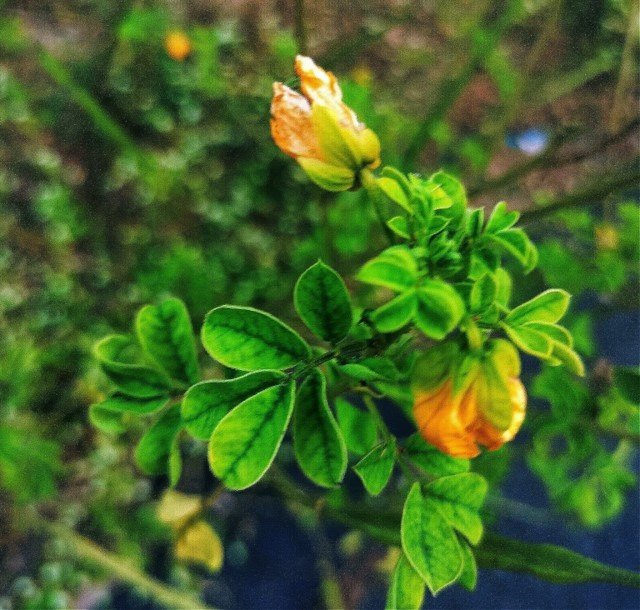
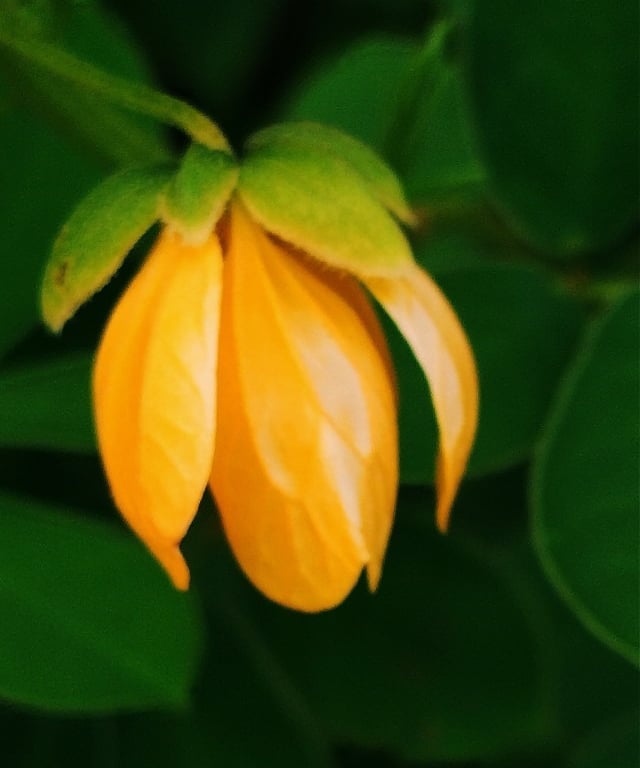
Senna obtusifolia: Sickle Senna Plant
Sickle senna or Chinese senna or American Sicklepod, belongs to family Fabaceae and scientifically called Senna obtusifolia. It is a erect shrub which grows up to a height of few meter. Stems branch profusely with compound leaves of two to three leaflets. Plant produces yellow flowers. Pods produced are downward curved, resembling sickles.
Plants are reported to have some medicinal benefits. The green leaves are fermented to produce high protein food and used as meat substitute in Sudan. Seeds are used to produce cassia gum, which is used as food additives and thickening agents in some preparation.
Ludwigia octovalvis, a annual herb, belongs to family Onagraceae. Plant is commonly known as Mexican Primerose willow.
Plants spread on ground by rooting at each nodes, thrive equally well as aquatic herb. Plant produces yellow flowers with four petals and four sepals.
Ludwigia octovalvis
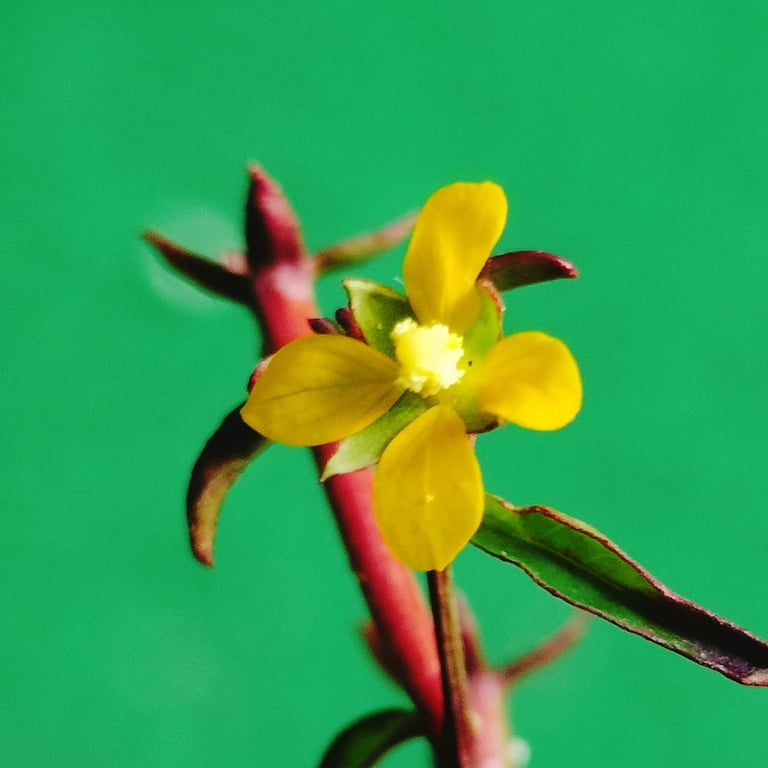
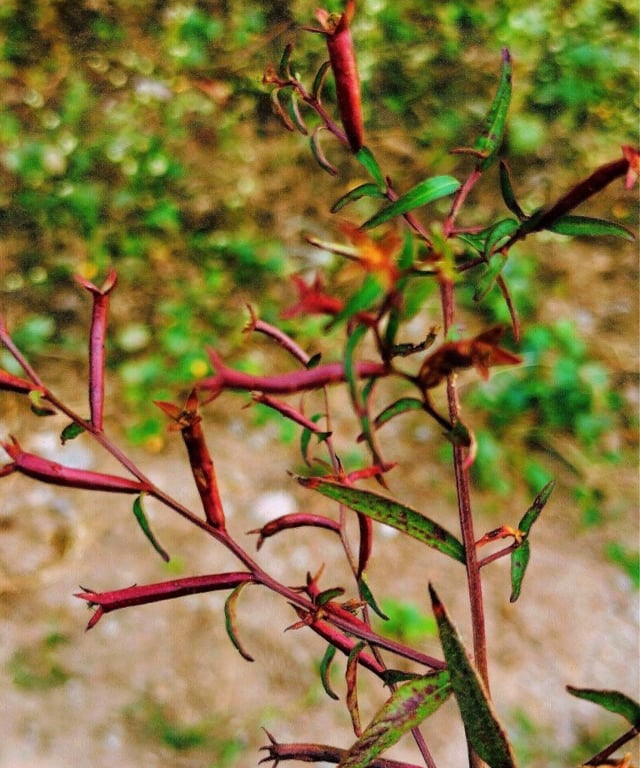
Oldenlandia umbellata: Chay (Choy) Root Plant
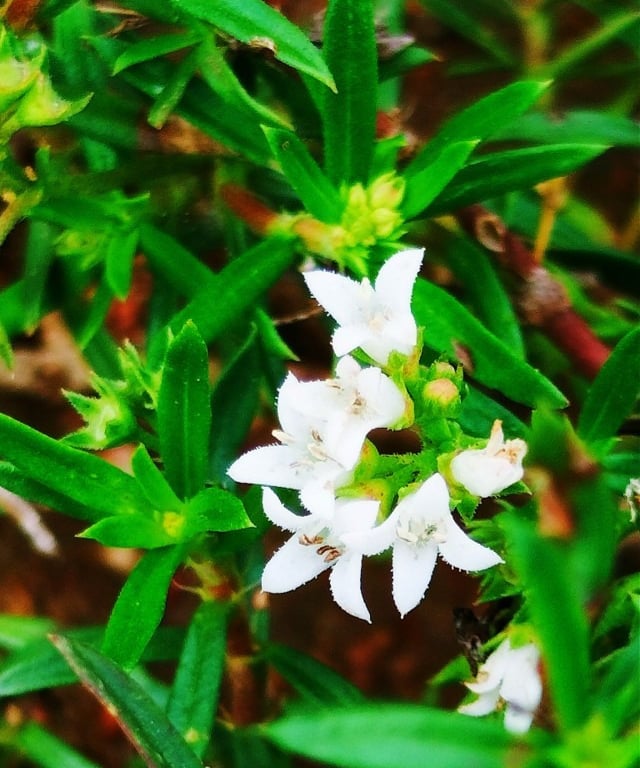
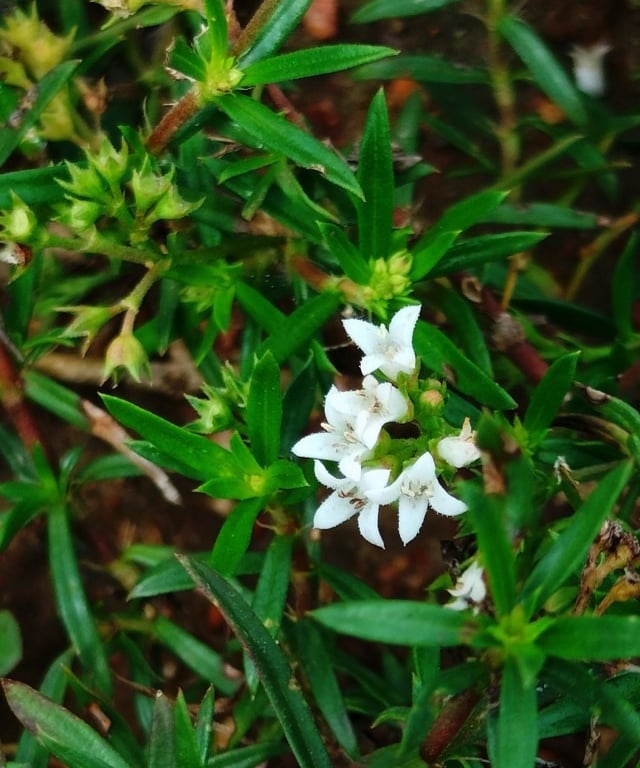
Chay or Choy Root plants are scientifically known as Oldenlandia umbellata, belongs to family Rubiaceae. It is a spreading kind of herbaceous plant. Leaves are linear, pointed at the tips, covered with hairs. Flowers are white or pinkish white produced in umbel like racemes, which are tubular in shape.
Roots and bark yields red dyes, use to color silk and woolen fabrics. It is believed that the decoction of the roots of the plant cure the asthmatic symptoms.
Roselle plant, scientifically known as Hibiscus sabdariffa, belongs to family Malvaceae. Plants are annual or perennial with woody stem, with three or five lobed leaves, alternatively arranged on them.
Flowers spread up to are of 8 to 10 cm diameter, white to pale yellow in color initially, turns crimson red as fruit matures. It takes around six month to have matured fruits.
Plants are cultivated to produce blast fiber used in preparation of ropes, jute bags and handicrafts. Flowers are used as vegetables in various part of India.
Hibiscus sabdariffa :Roselle Plant
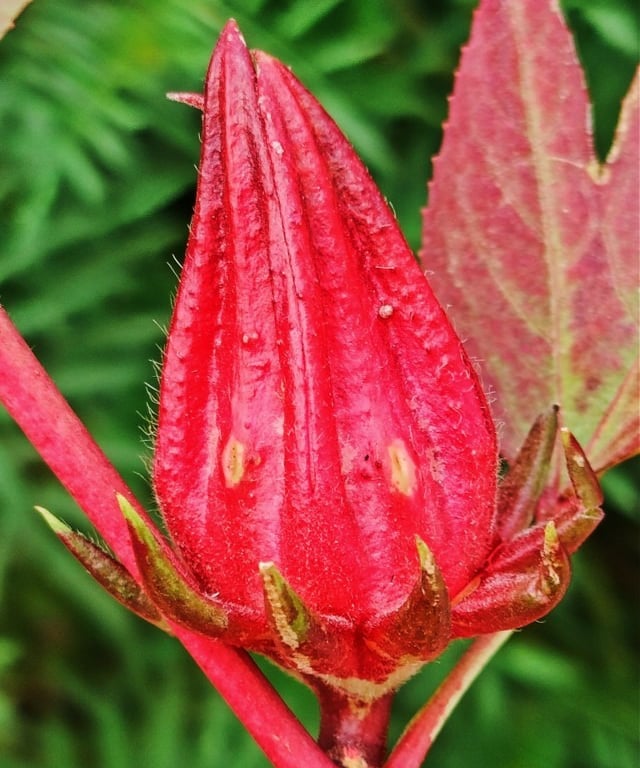
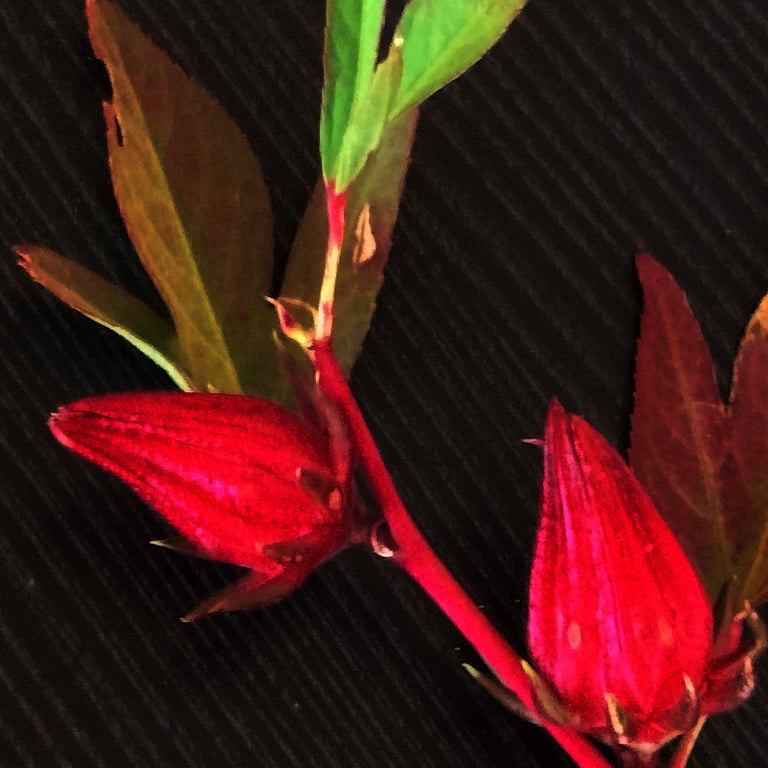
Sida cordifolia, an annual or perennial herb belongs to family Malvaceae. Plants are otherwise called as Flannel Weed or Heart Leaf Sida. Leaves are oblong - ovate with serrated edges with hairs covered over them. Flowers are solitary with dark yellow colored petals. Plant is a invasive weed because of its adaptability to various climate and habitat.
Sida plants are called as Bala in sanskrit, has great medicinal value according to Ayurveda.
Sida cordifolia: Sida Plant
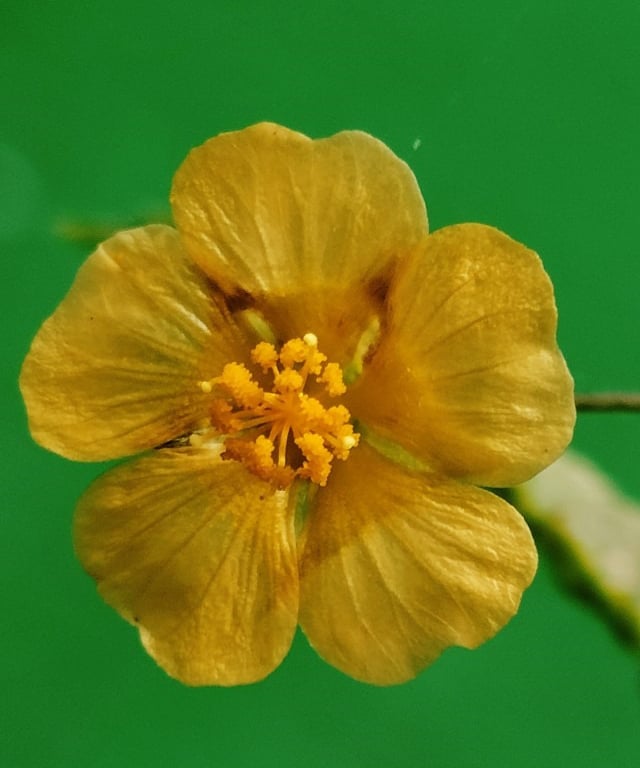
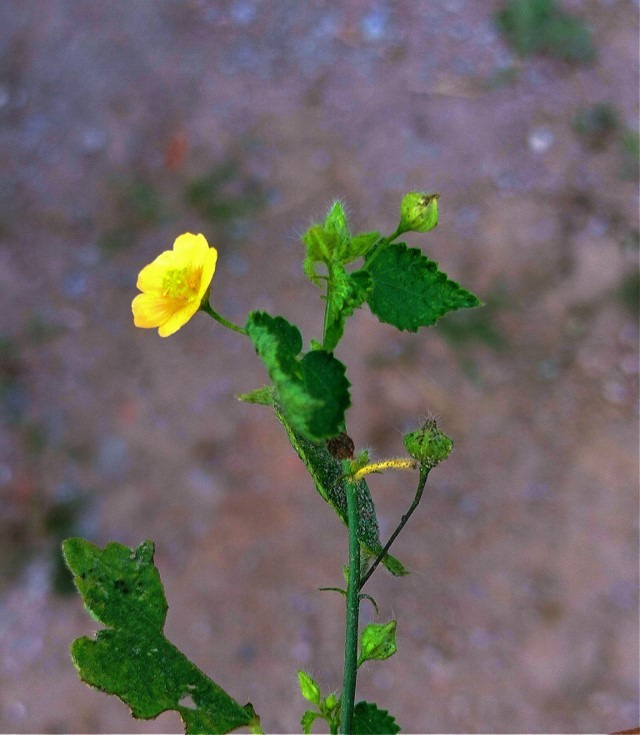
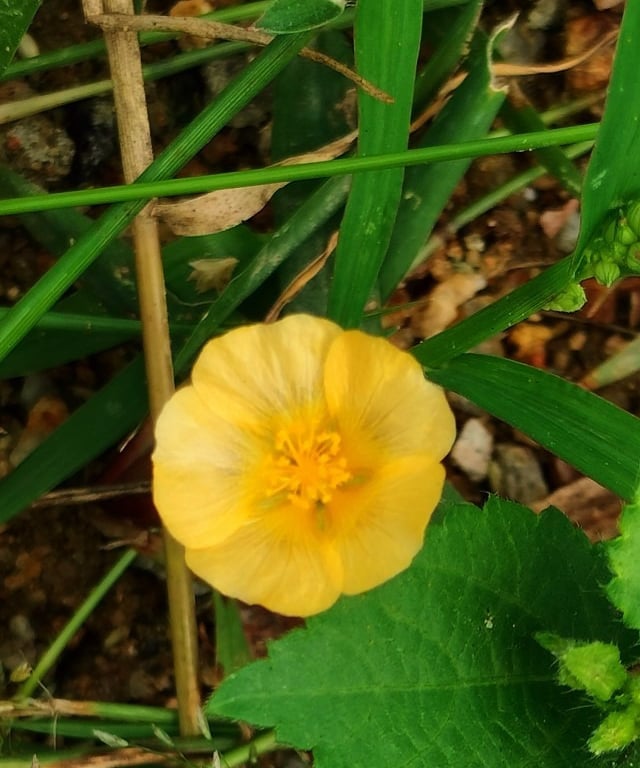
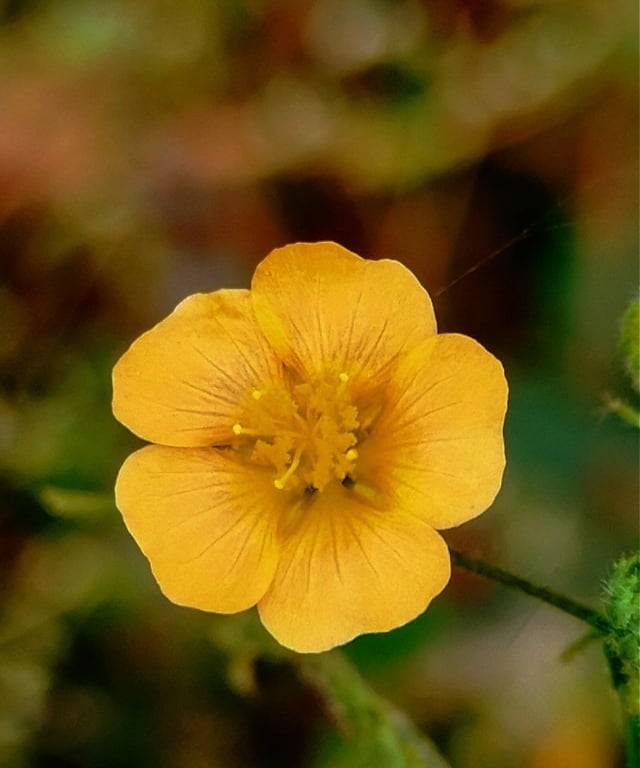
Merremia tridentata: Chinese Moon Creeper
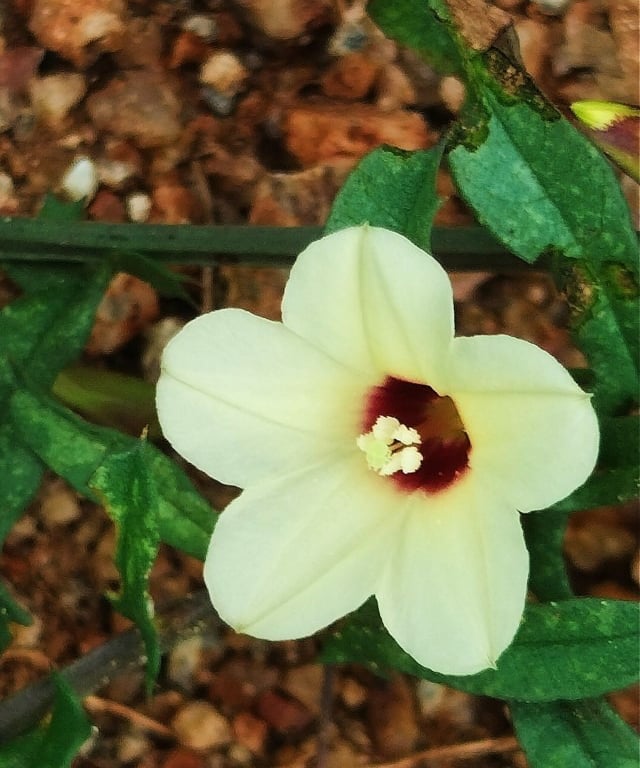
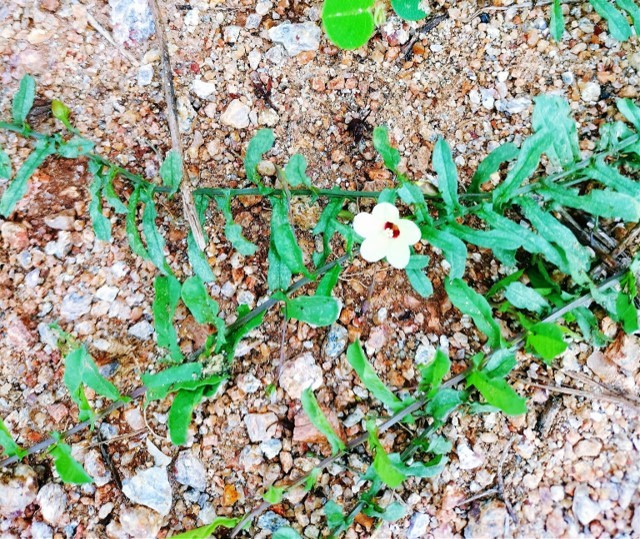
Merremia tridentata is a spreading or prostrate herb with common names Arrow Leaf Morning Glory or African morning vine. It belongs to family Convulvulaceae. It grows up to length of 2 m. Leaves are simple, alternate, petiolated and hairy. Flowers are funnel shaped, pale yellow or creamy or whitish in color. Plants have some therapeutic properties.
Ipomoea aquatica, a semi aquatic , tropical plant, widely known as Water Spinach. Plant can grow at marshy land and on water bodies, with tender and hollow stem, which helps in floating on water. Leaves vary from sagittate to lanceorate.
Flowers are trumpet shaped with white color and pale purplish center. Plants belong to family Convolvulaceae
Though the plants are declared as noxious weed in USDA because of its invasiveness, widely cultivated in south East Asian countries for edible purposes.
Ipomoea aquatica: Water Spinach
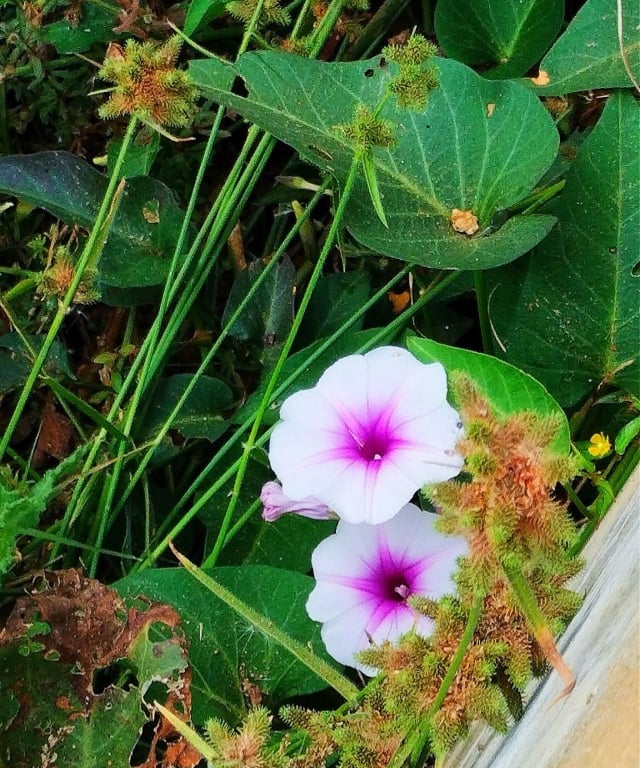
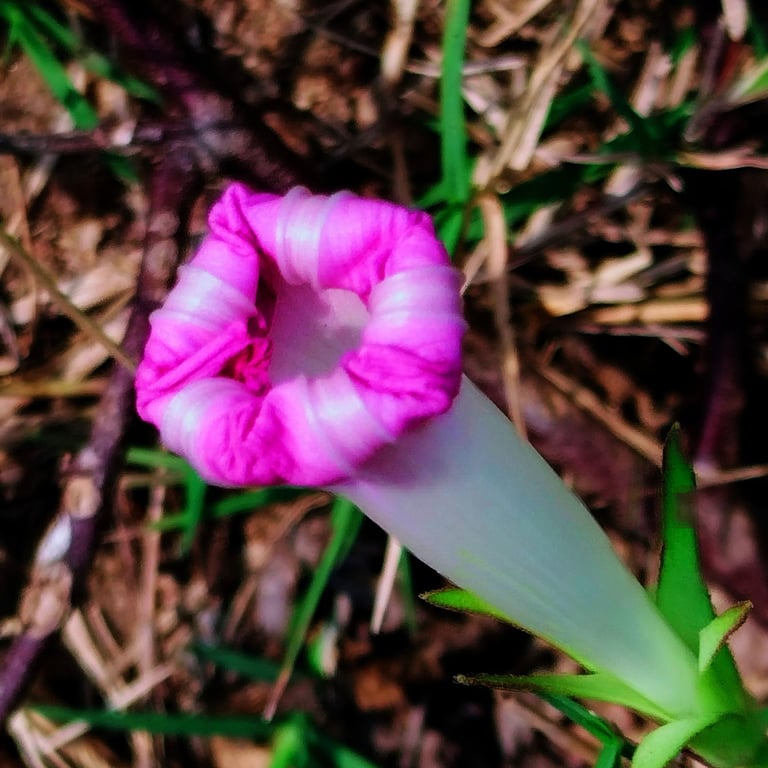
Merremia hederaceae is a prostrate or twining herb, belongs to family Convulvulaceae. It is commonly known as Ivy Wood Rose.
Leaves are heart shaped, blunt at the tips and with shallowly toothed edge. Flowers are single, yellow or white in colour, trumpet shaped,
Merremia hederaceae: Ivy Wood Rose
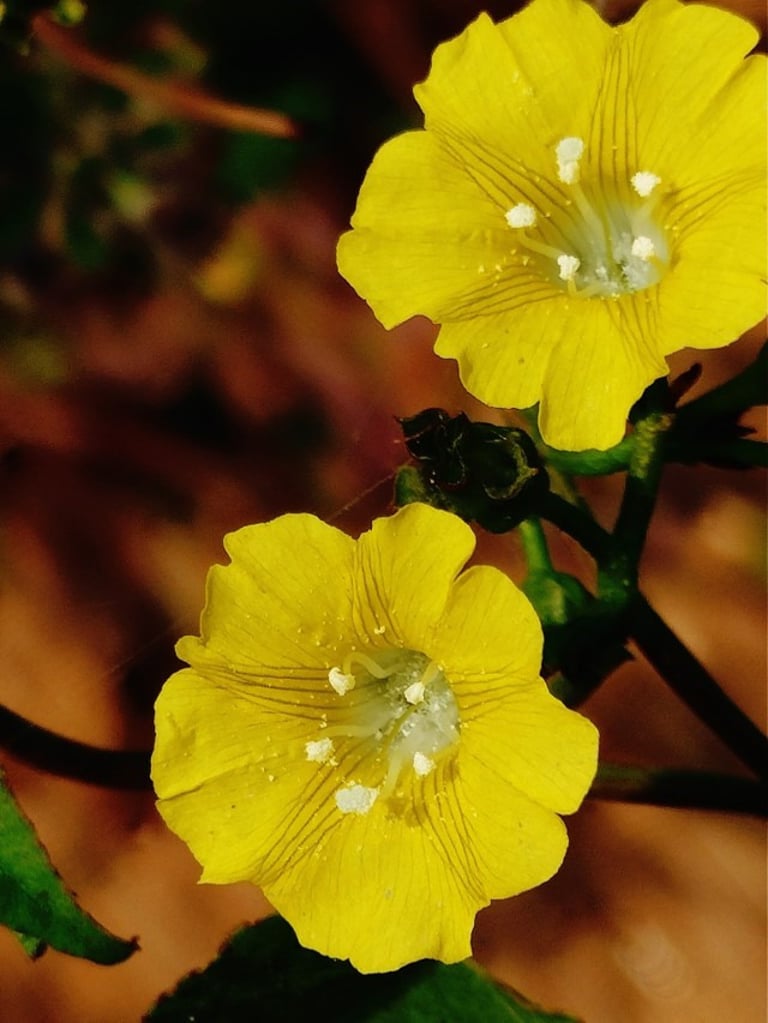
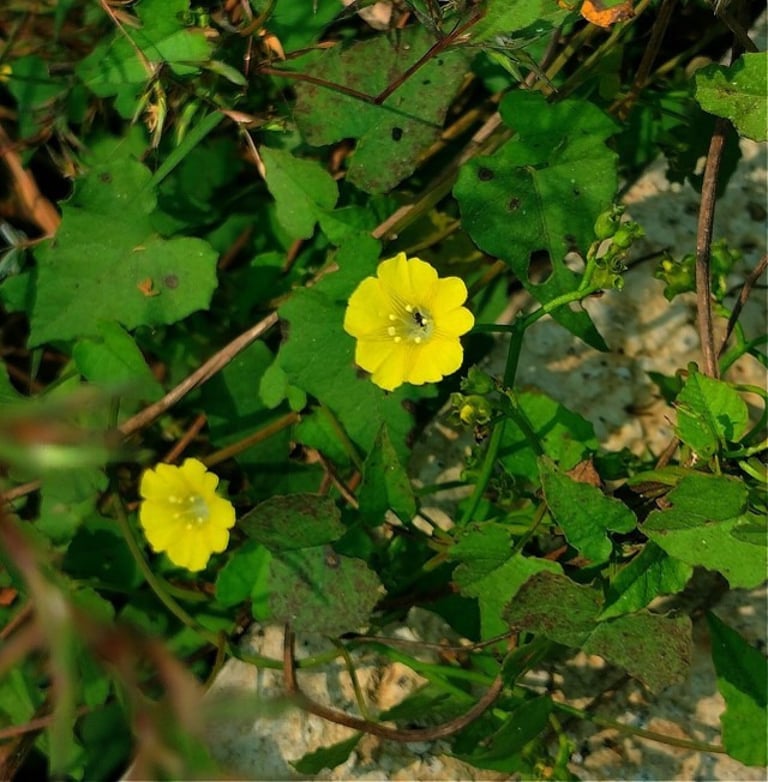


Jatropha gossypiifolia is a plant belongs to family Euphorbiaceae. Jatropha curcas, another common species of this family known for its cultivation for biodiesel production.
It is commonly known as Belly Ache Bush or Black Physicnut. Leaves are tri-lobed, purple and sticky when young and turns green when mature. Small red flowers with yellow center appear in clusters during reproductive stage. Plants are reported to have medicinal use in veterinary and human traditional medication.
Jatropha gossypiifolia: Jatropha Plant
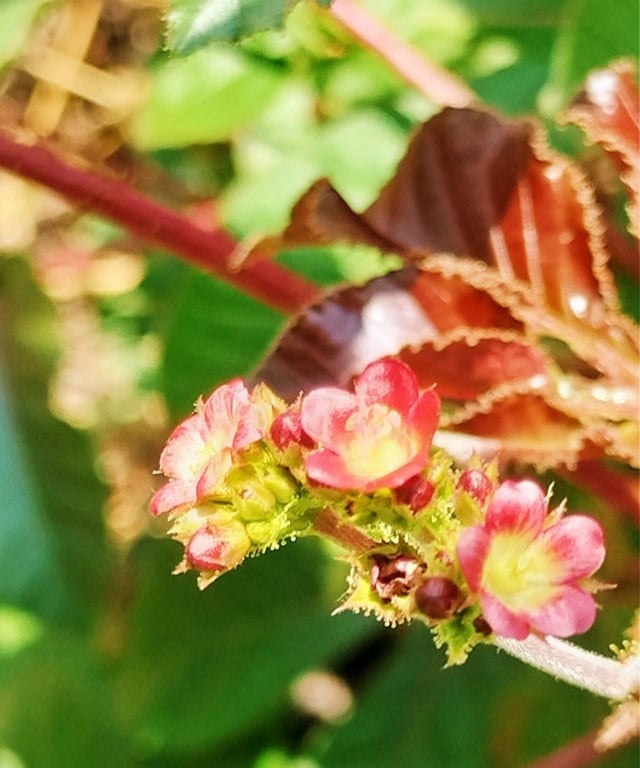
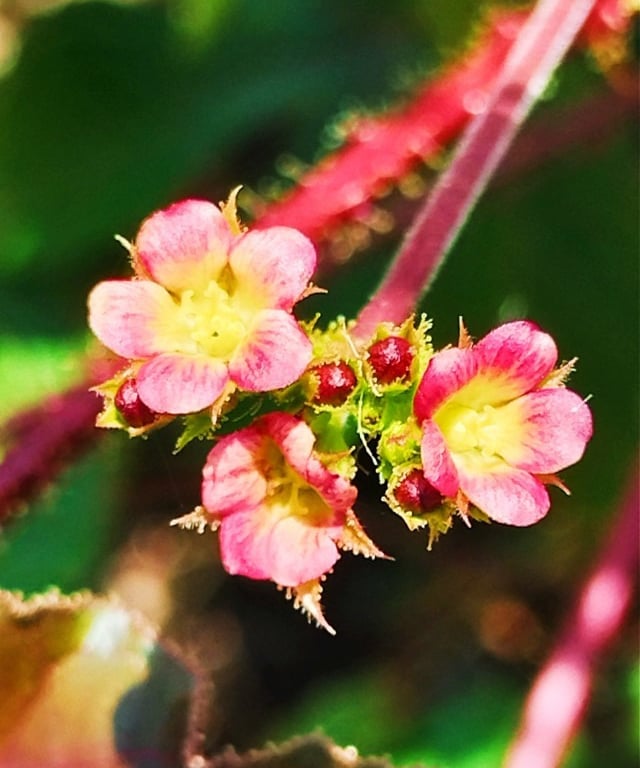
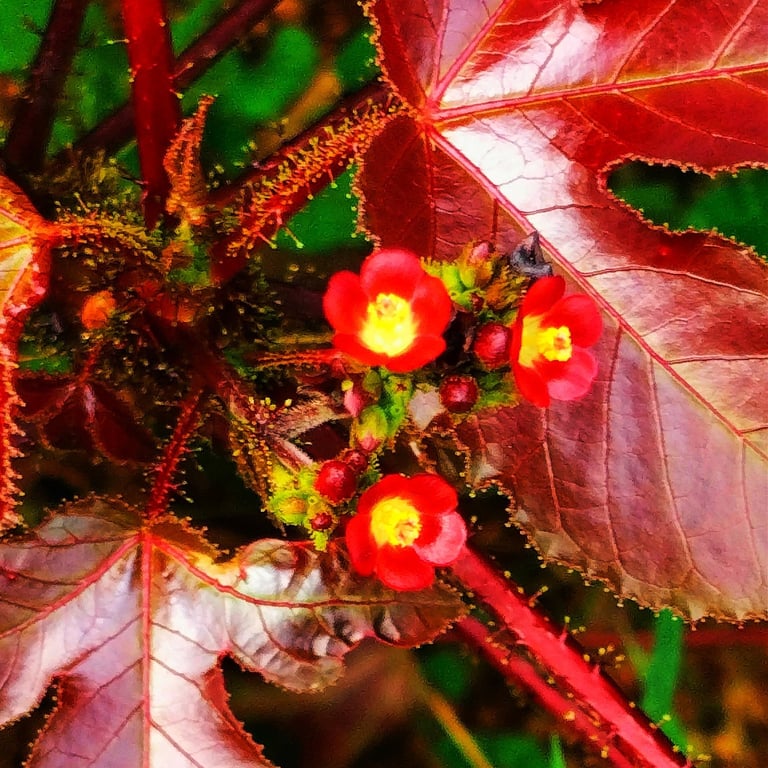
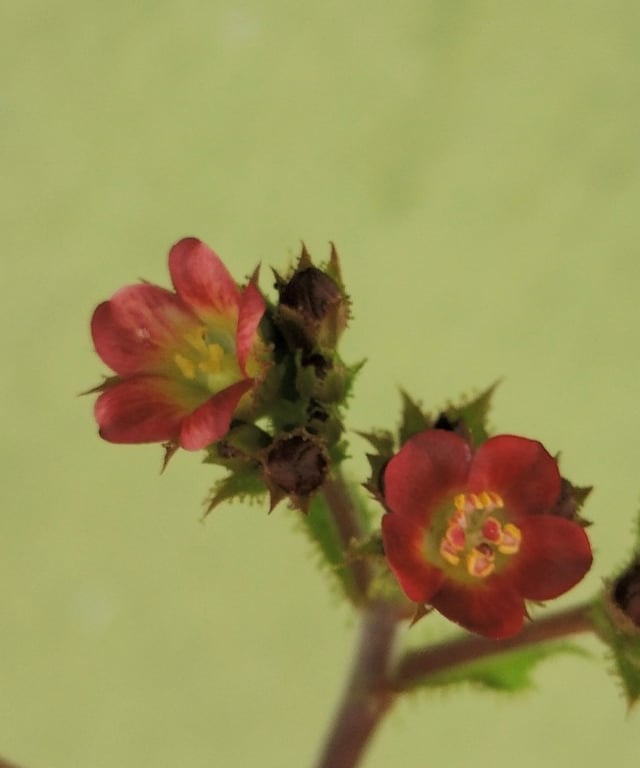
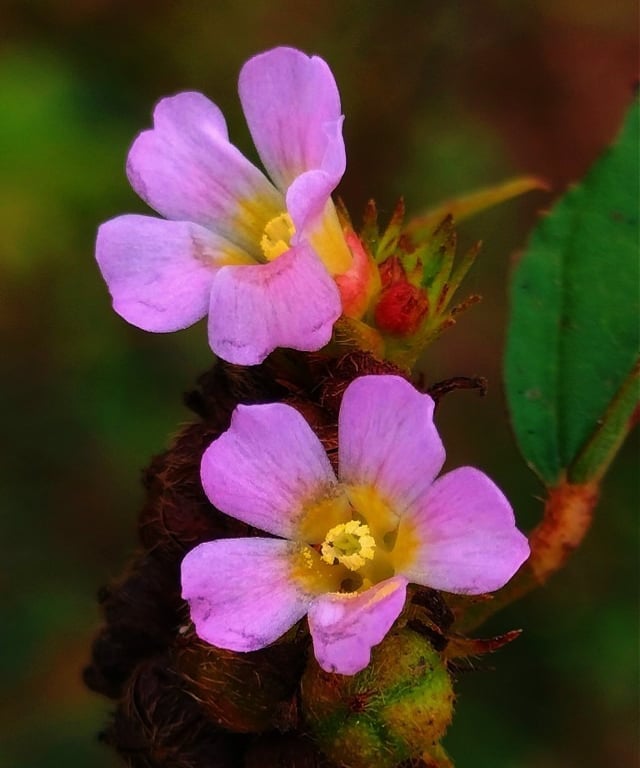
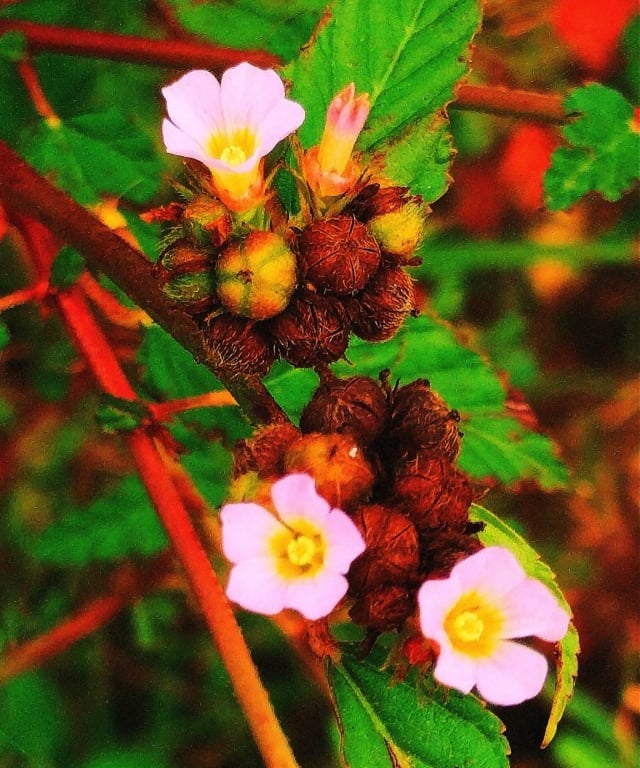
Melochia pyramidata: Pyramid flower plant
Pyramid flower plant or Melochia pyramidata belongs to family Sterculiaceae It is a herbaceous erect plant, grows up to a height of 1 m. It is found growing mainly in sand or rocky habitat. Leaves are lance shaped with serrated margin. Flowers are with purple petals and yellow center. Fruits produced are rough, scaly and pyramid like .
Grangea maderaspatana, commonly known as Madras carpet, belongs to family Asteraceae. Plants have cylindrical root system with profusely branching stem.
Plant bears solitary flower head with yellow florets. Plant prefers marshy places with warm temperature.
Grangea madaraspatana: Madras Carpet
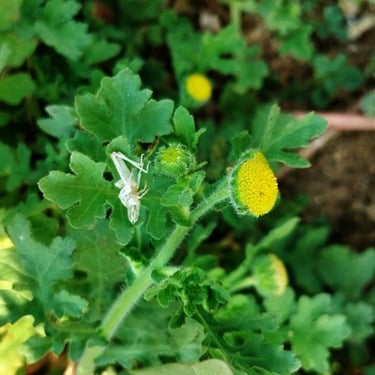
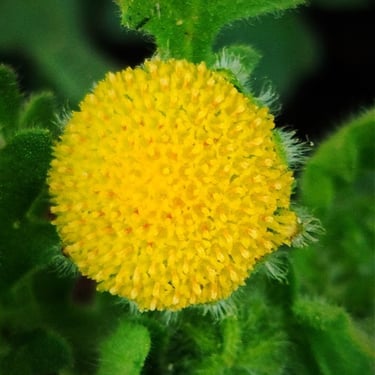

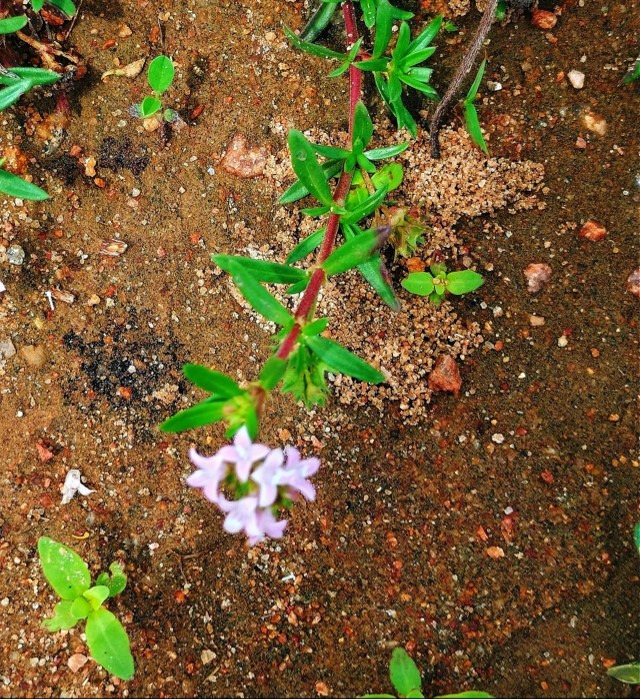
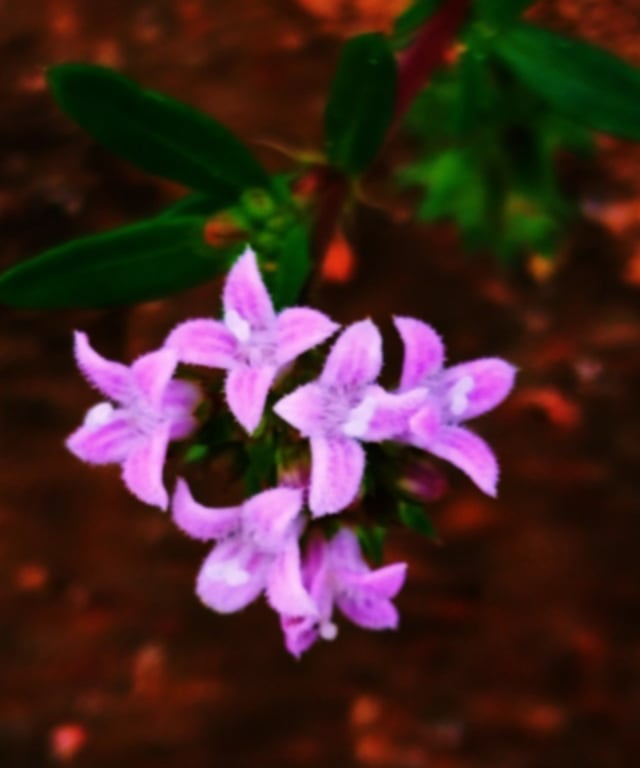
Kohautia aspera: Rough Diamond flower plant
Kohautia aspera is commonly known as Rough Diamond Flower Plant, belongs to family Rubiaceae. Plants are erect or prostrate herb grow to the height of one or two foot. Entire plant is rough. Flowers are linear and appear in clusters and are white or light blue in color. Plants bear flowers in November to February.
Mesosphaerum suaveolens, otherwise known as Pignut plant. It is a pseudo cereal plants which grow up to the height of 1 to 3 m. It belongs to family Lamiaceae.
Leaves are arranged oppositely and with shallow toothed margin, emit minty odor on crushing. Flowers are pink or purple, appear in cluster at upper leaf axils.
Plants are said to have insecticidal properties. In some parts, plants seeds are used to prepare refreshing drinks, by adding sugar and lemon and refrigerating.
Mesosphaerum suaveolens: Pignut Plant
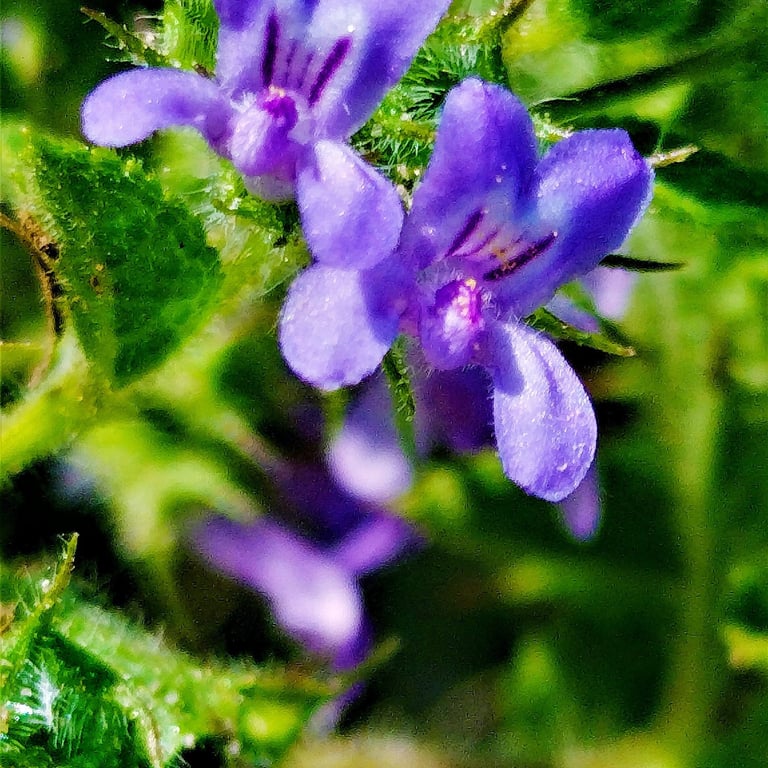
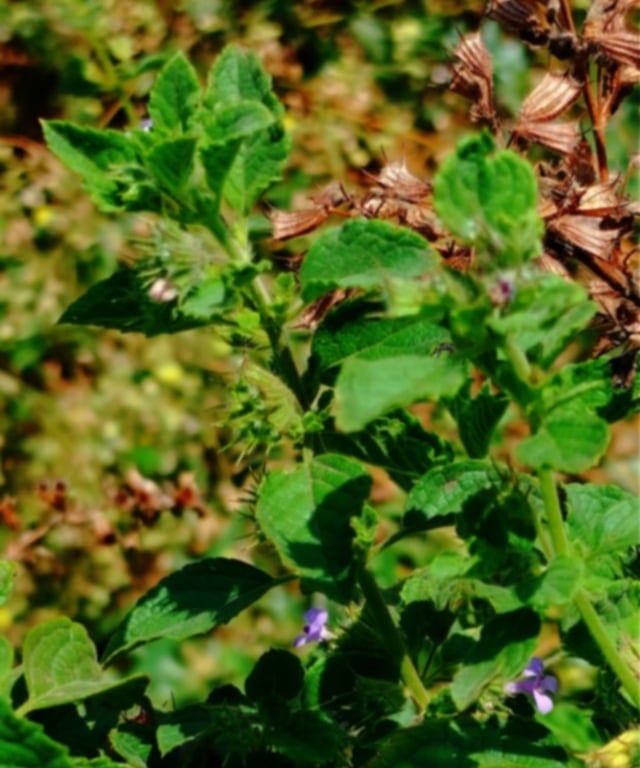
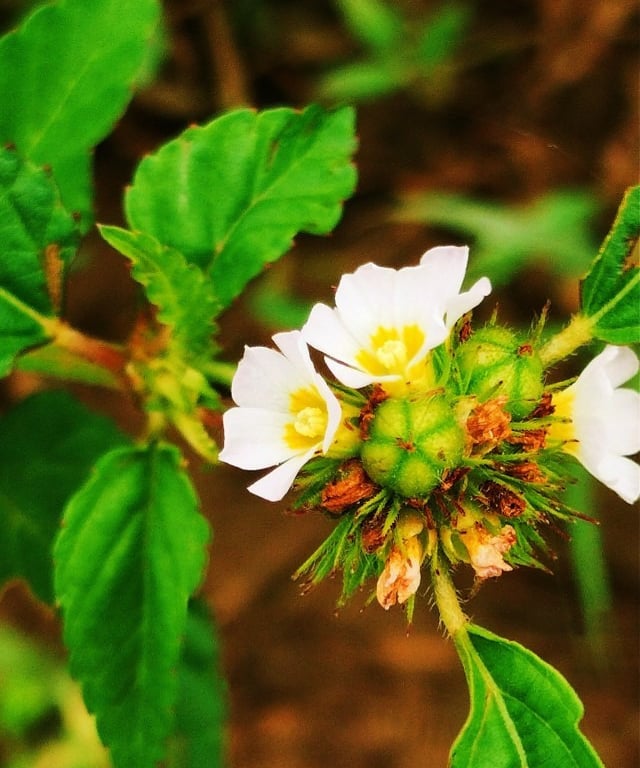
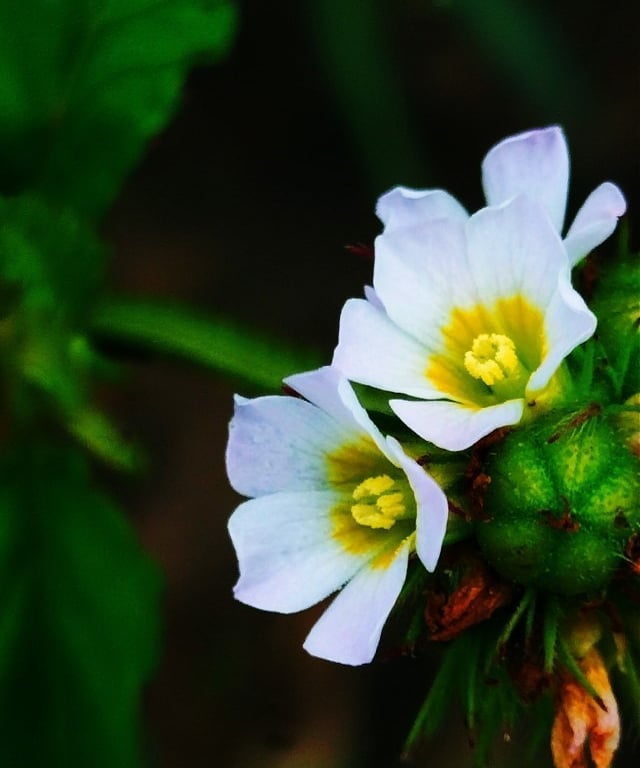
Melochia corchorifolia: Chocolate weed plant
Melochia corchorifolia, a invasive weed found in open land, known as Chocolate Weed plant. It belongs to family Malvaceae. It is a perennial herb which grows to a height of 2 m. Stem is hairy and leaves are petiolated, ovate, simple, spirally arranged and serrated. Flowers are white or purple with 5 petals. Fruits are covered bristles and contain five valved capsules. Plant believed to have some medicinal properties because of the presence of various phyto -chemicals.
Senna bicapsularis is a plant of Fabaceae family. It is otherwise called as Rambling Senna or Winter Cassia or Christmas bush. It is a sub ever green shrubs.
Leaves are pinnate with six to eight leaflets. Plant bears yellow flowers in masses during autumn to winter. They are considered as invasive weed in several part of the world.
Leaves are edible in some parts and used for medicinal purposes in some other.
Senna bicapsularis: Winter cassia
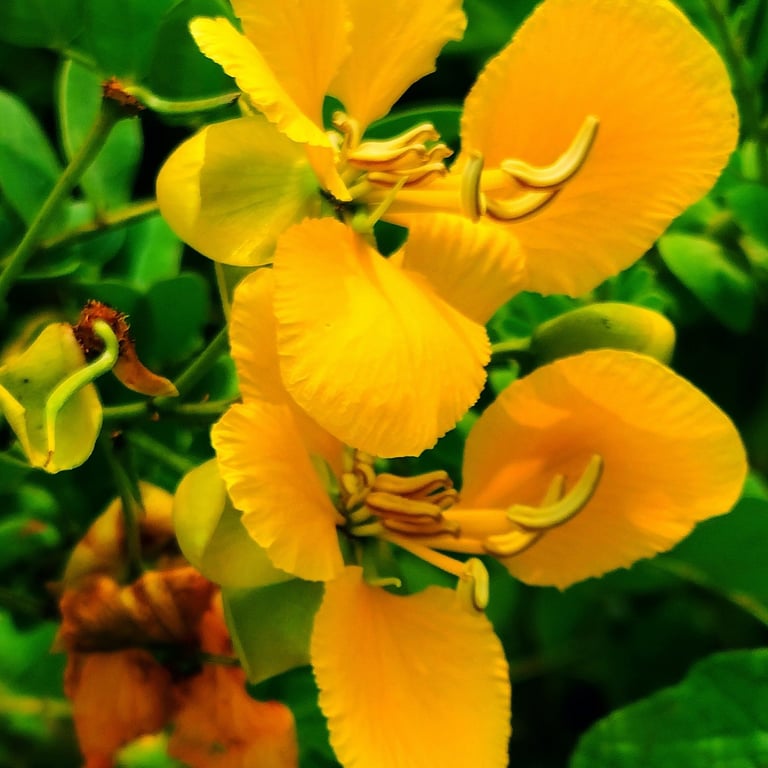
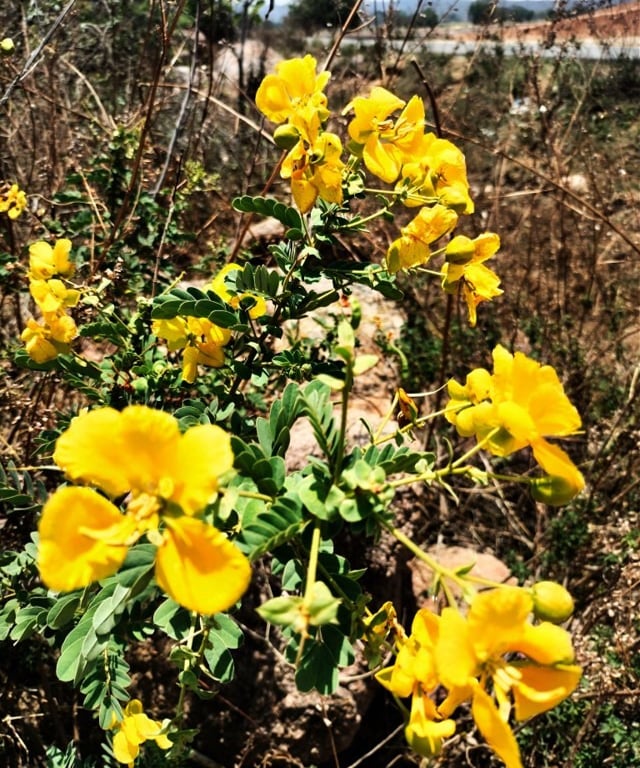
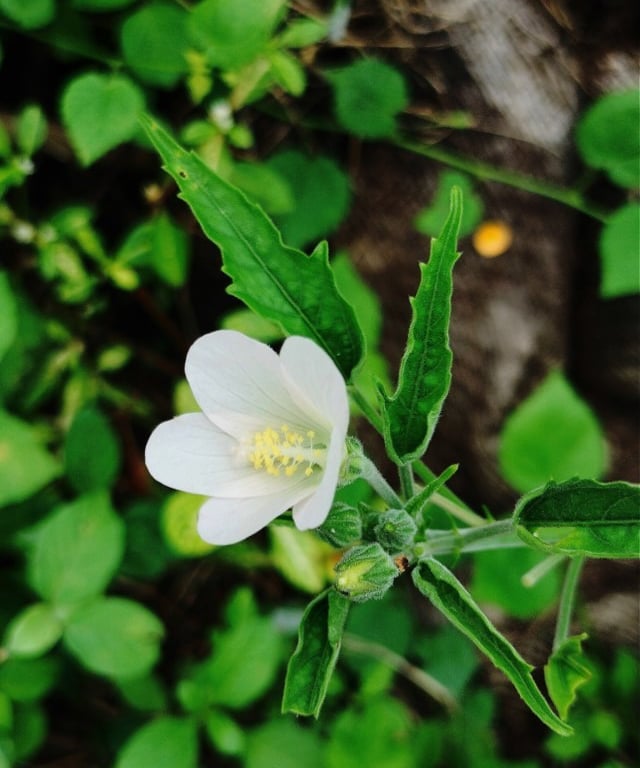
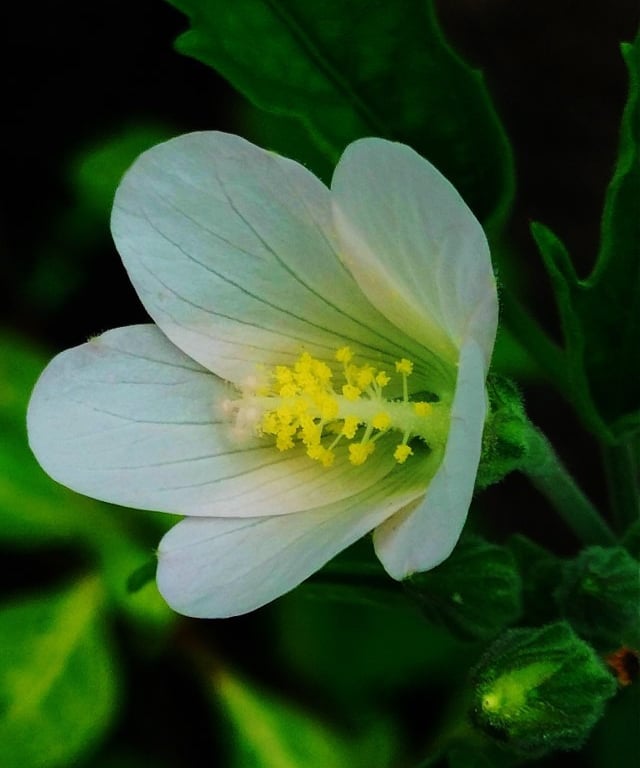
Hibiscus lobatus: Lobed Leaf Mallow
Hibiscus lobatus, otherwise known as Lobed leaf Mellow, belongs to family Malvaceae. It is an erect annual herb which grows to a height of 50-60 cm. Leaves are elongated with long petioles. Flowers are white or yellow in color with Pseudo-sepals and produced singly.
Evolvulus alsinoides, commonly known as Slender Morning Glory or Dwarf Morning Glory, belongs to family Convolvulaceae. Plants are annual or perennial with prostrate or ascending stem with hairs spread all over. Plants grow in marshy land invasive manner.
Leaves are with stalk or sessile. Flowers are isolated or in group with filiform peduncles. Sepals are lanceorated, corolla rounded with pentametric symmetry and blue in color. The stamens are with filiform filaments which are fused at the base to corolla tube.
Evolvulus alsinoides: Dwarf Morning Glory
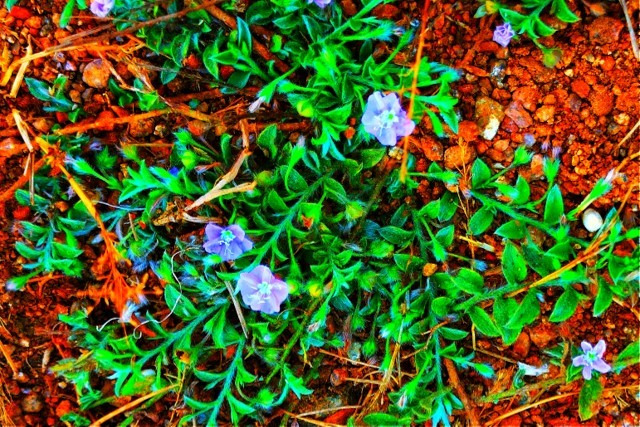
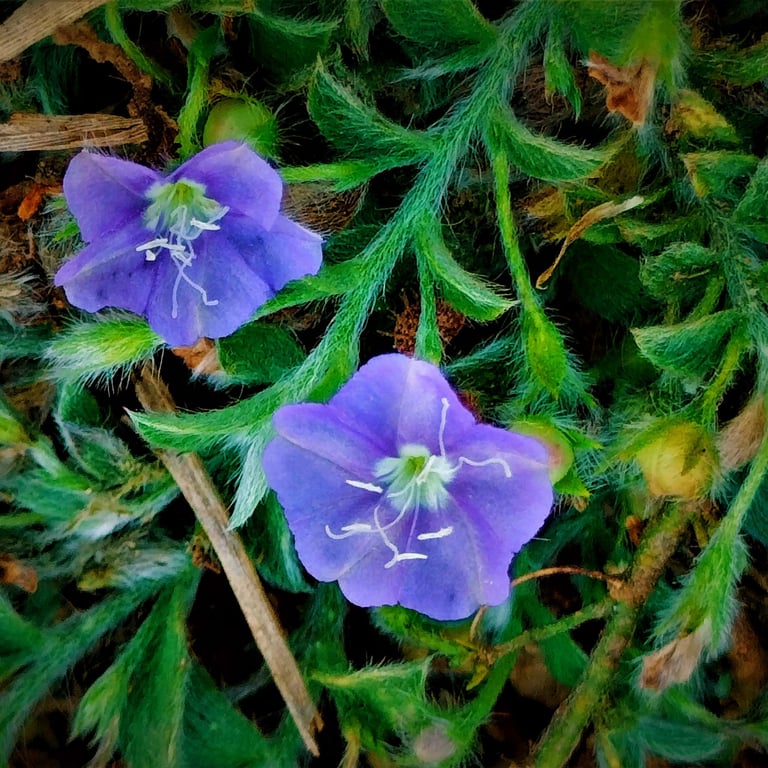
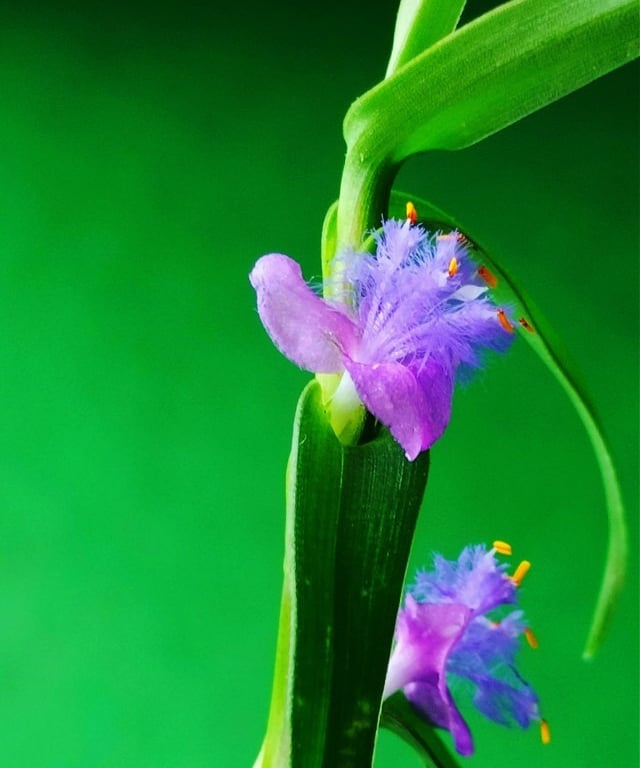
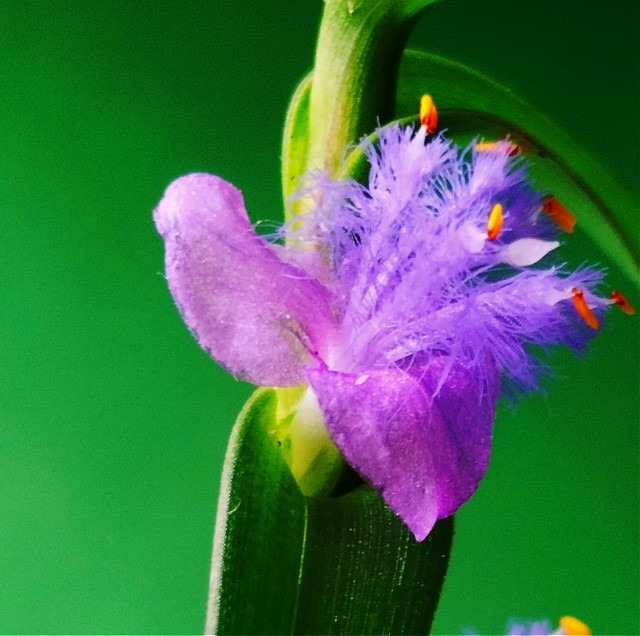
Cyanotis arachnoidea: Dew Grass
Cyanotis arachnoidea belongs to family Comellinaceae, common name is spider dew grass plant. Stem is succulent and erect. Leaves form the sheaths around the stem. Flowers are blue or purple which are axillary or terminal and ephemeral in position. They lack nectar, but have only pollen. Flowers are hermaphrodite.
Cyanthillium cinereum, called as Little Iron weed, is a perennial plant belongs to family Aesteraceae. Stem of the plant is either green or purplish green, with lanceorated oblong leaves arranged on it. Plants bear flowers from July to October which are purple or pinkish in color.
Cyanthillium cinereum: Little Iron Weed
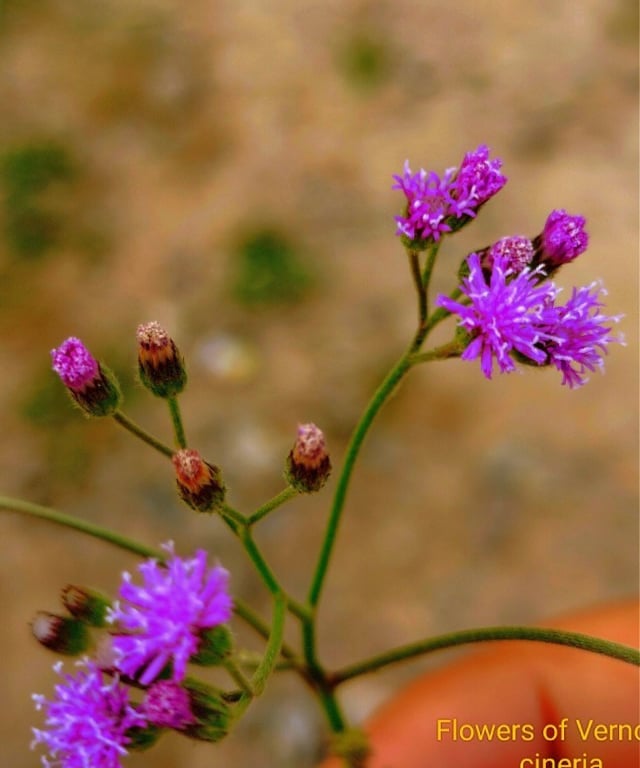
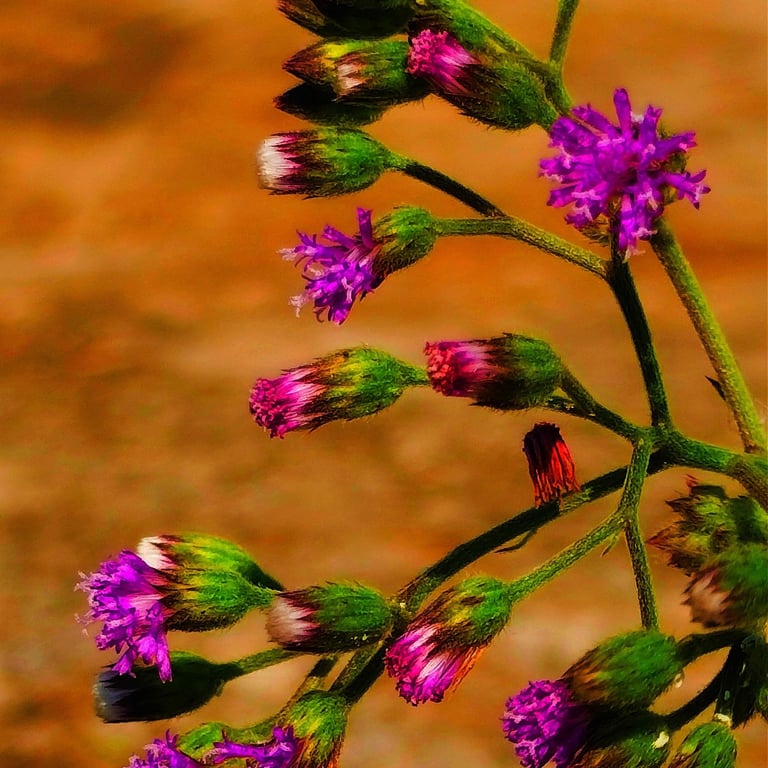
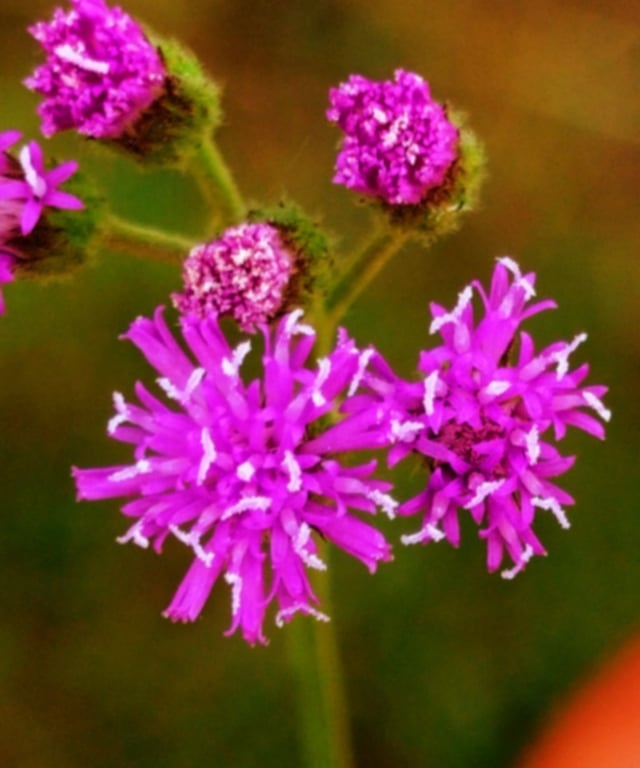
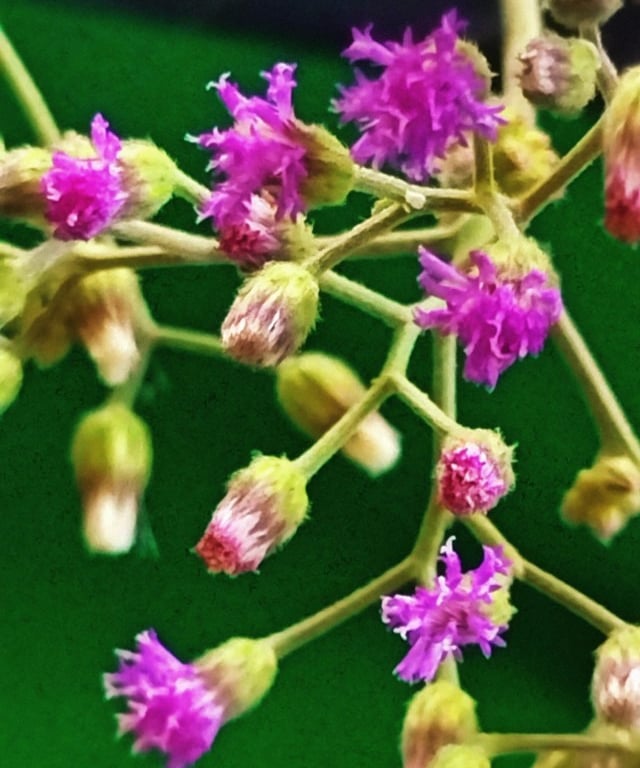
Ipomoea obscura which is known as obscure morning glory, belongs to family Convolvulaceae. Plants are prostrate or ascending, with heart shaped and alternately arranged leaves.
Plants bear pale yellow flowers where petals are fused to form trumpet shape. Usually plants grow in well drained soils.
Ipomoea obscura: Obscure Morning Glory
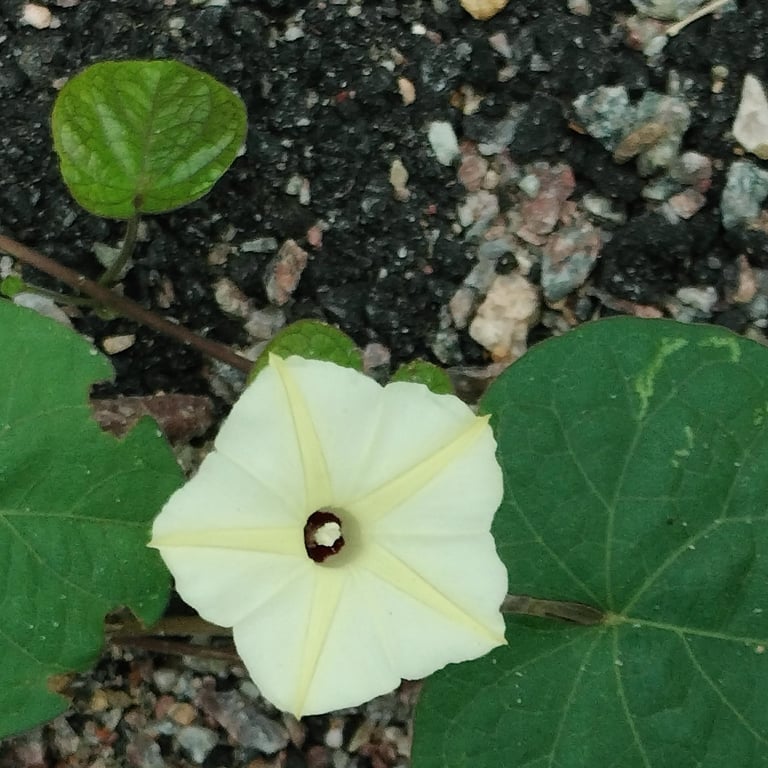
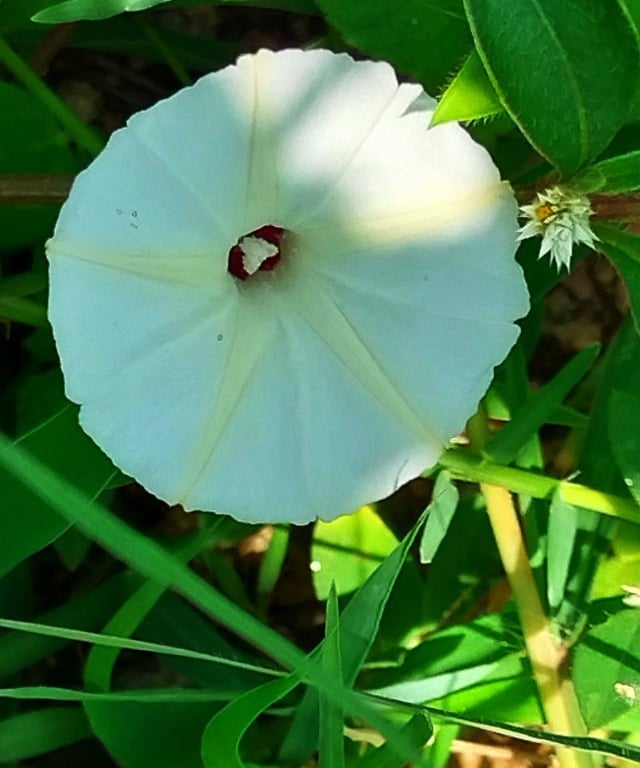
Alternanthera philoxeroides, commonly called as Alligator Weed, a invasive weed species belongs to family Amaranthaceae. Weed is well adopted to both dry and humid conditions.
Plant produces horizontal stems which are hollow and able to float on water bodies. At suitable condition plants branch profusely to produce thick mat on ground or water bodies. .This dense mat produced affects the growth of other species and disturbs soils aeration.
Leaves are simple and oppositely arranged, appear at the nodes. Plant bears whitish papery flowers with no or short stalks.
Alternanthera philoxeroides : Alligator Weed
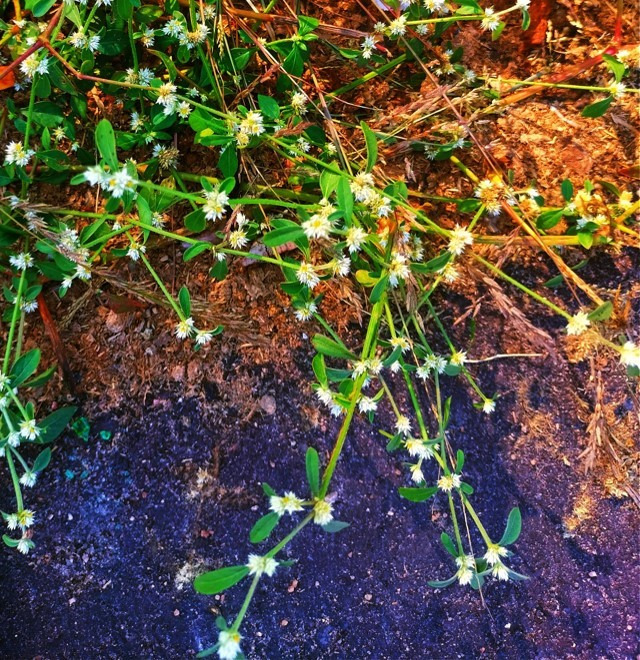
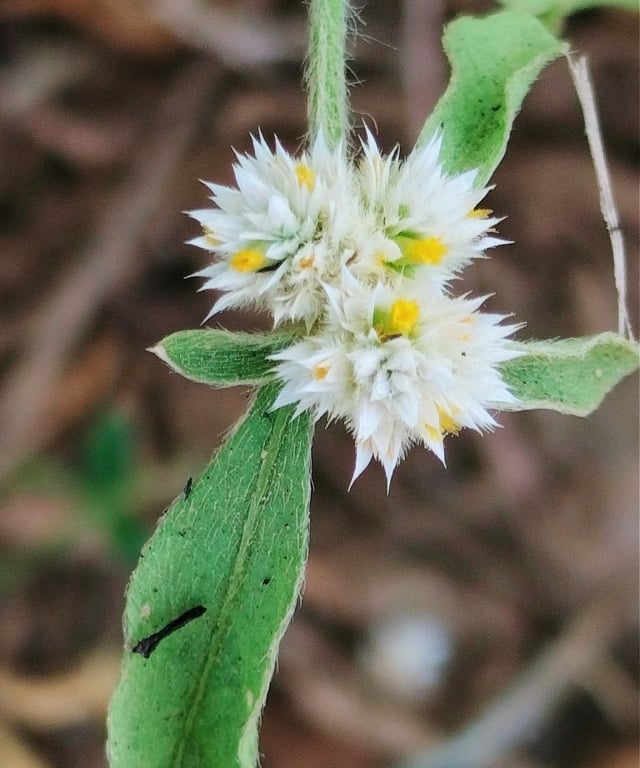
Newsletter
Sign up for our newsletter and get notified about all new posted articles.
ADDRESS
House No. 2-113(P), Visnumurthynagar, Kelarkalabettu, Thenkanidiyuru, Udupi
cONTACT
7975809540
satishmqc362@gmail.com
